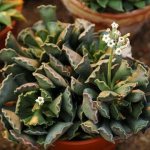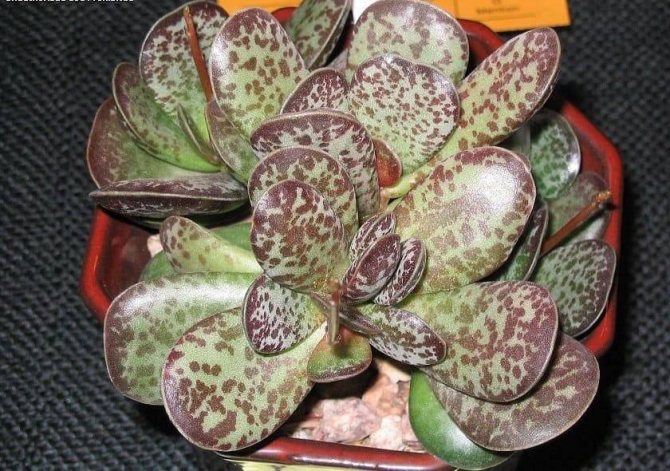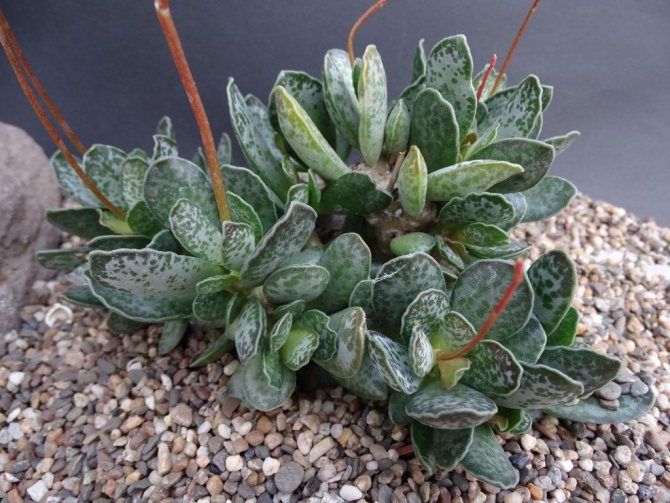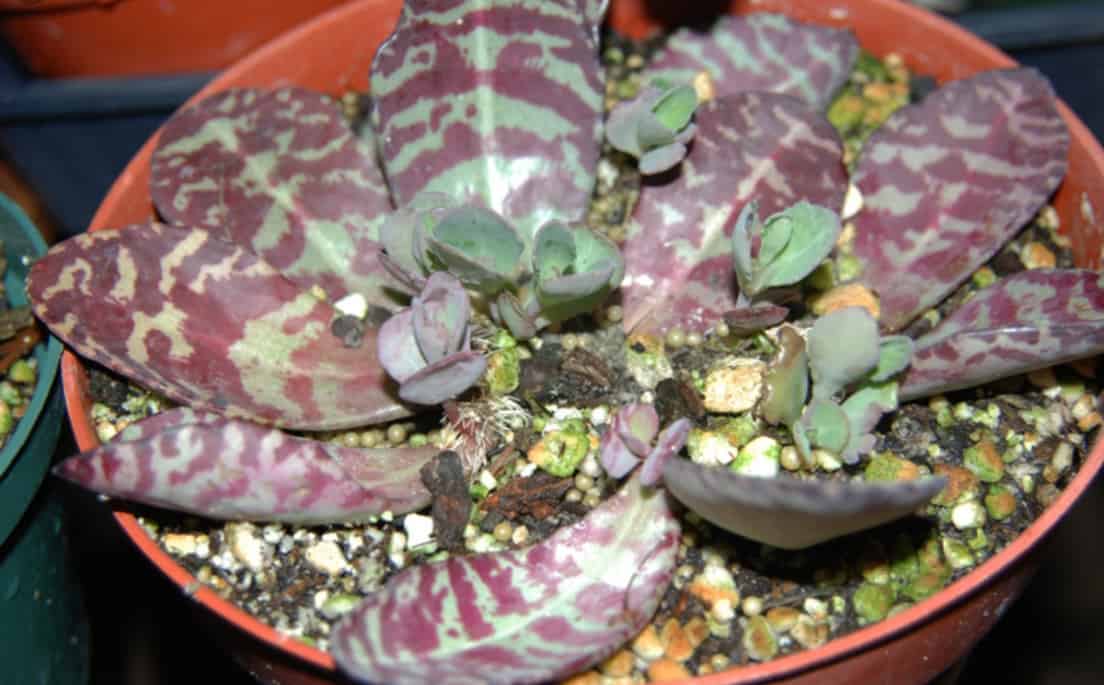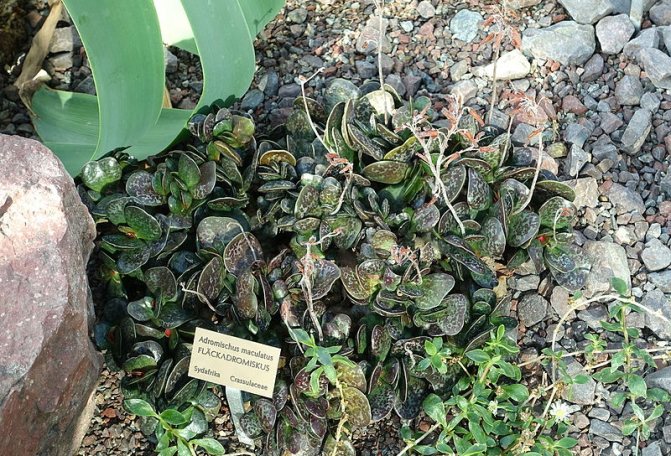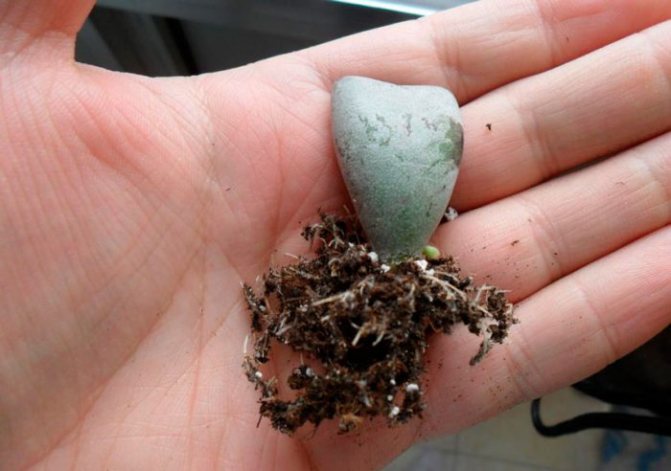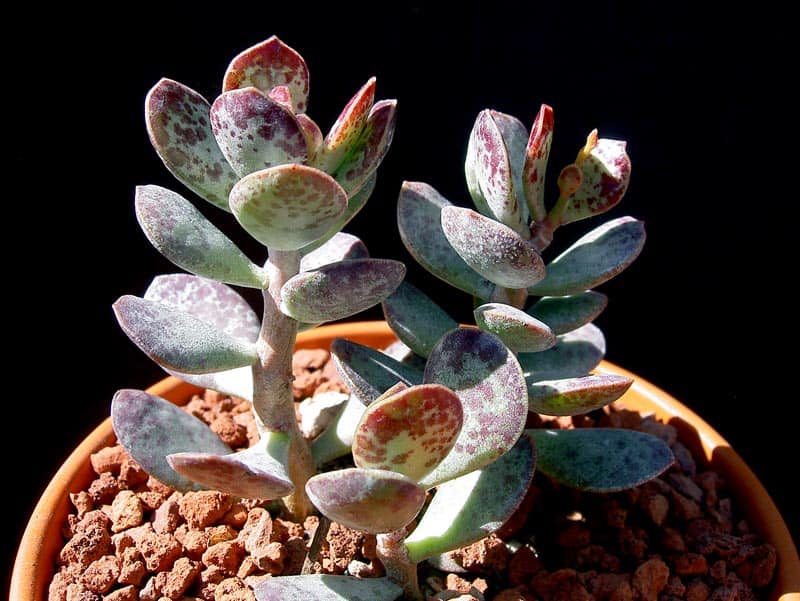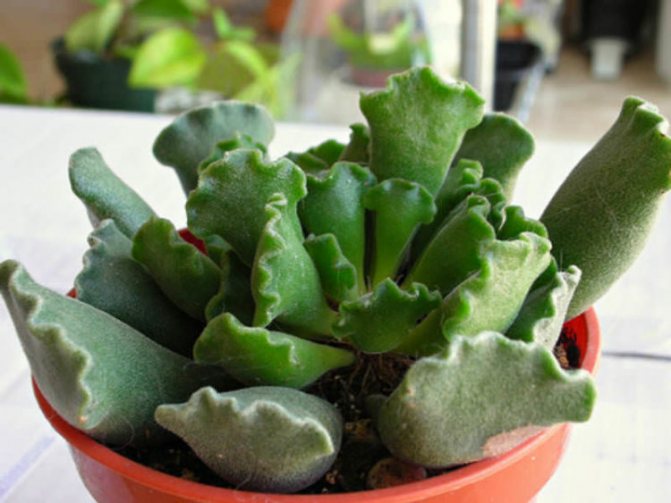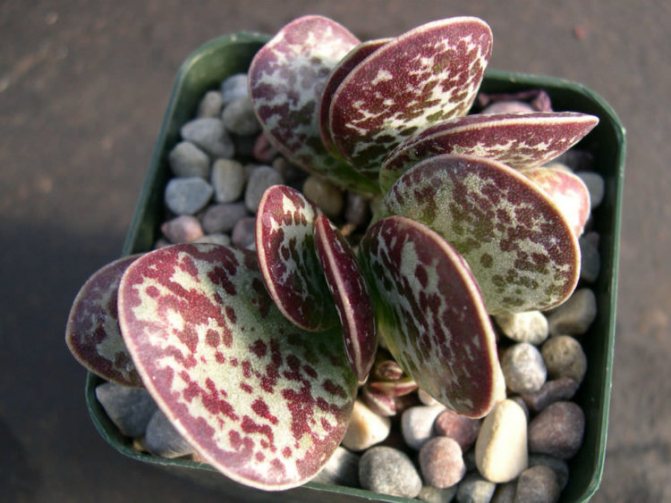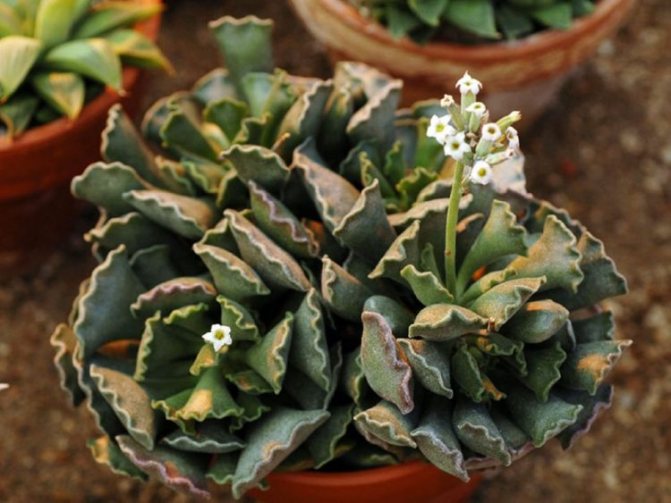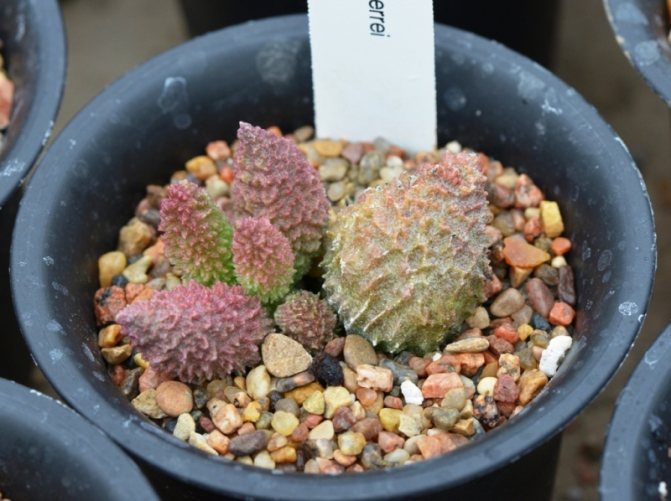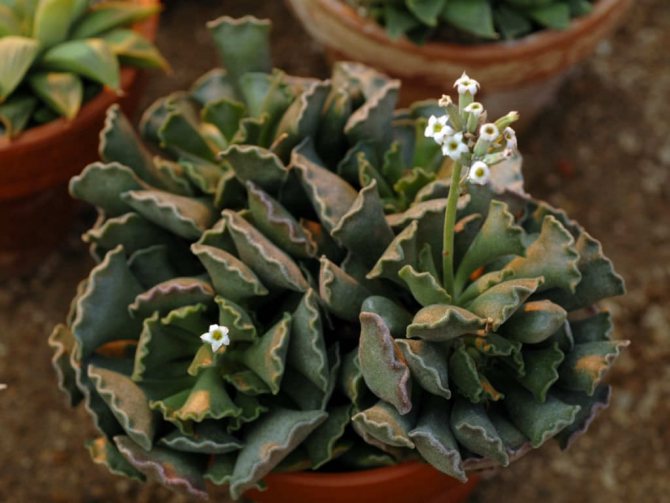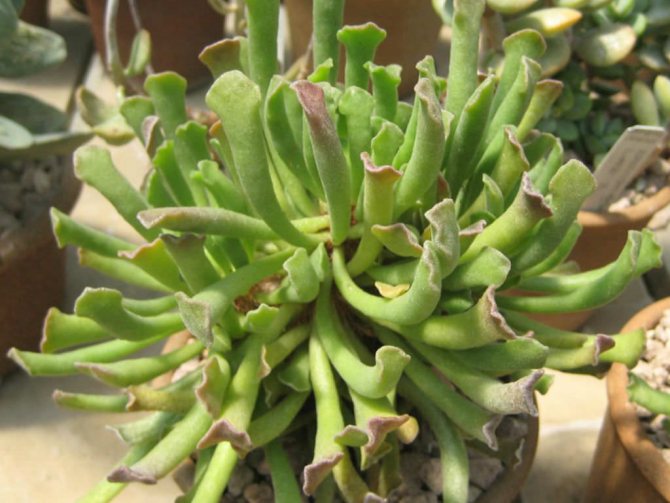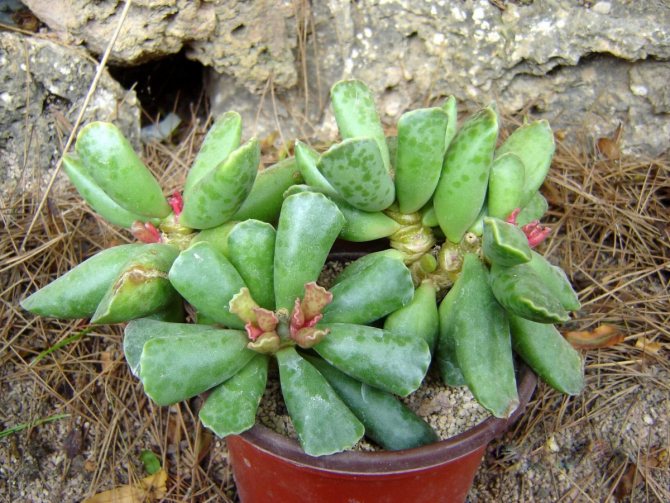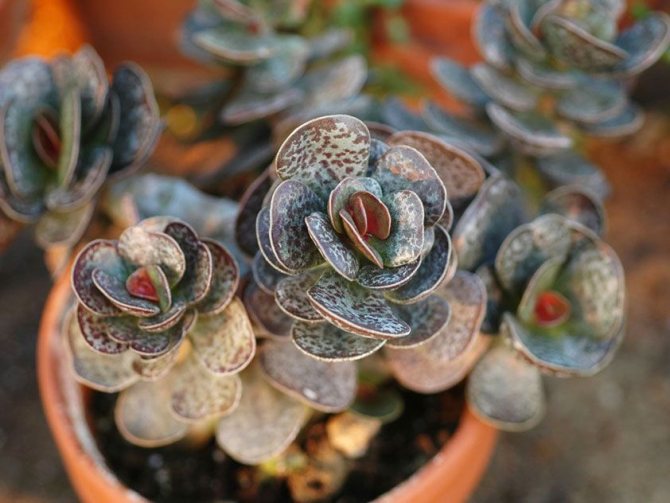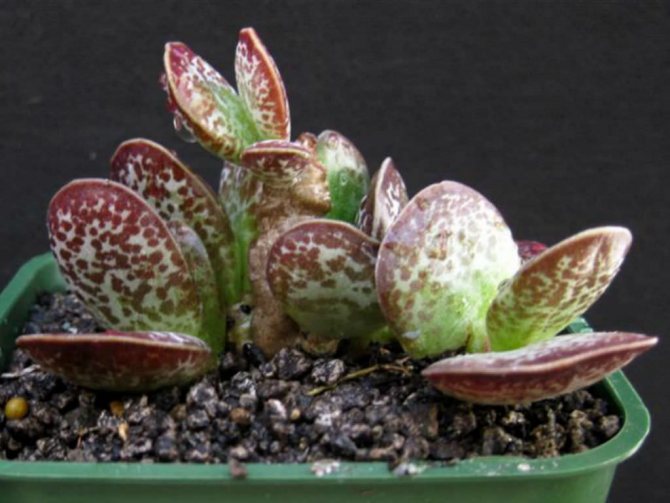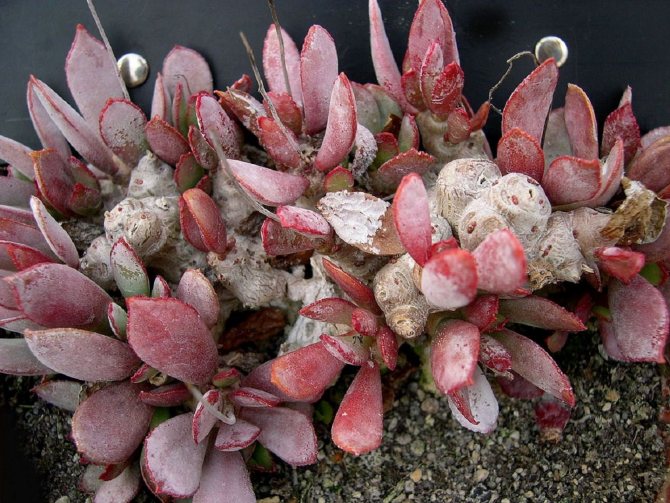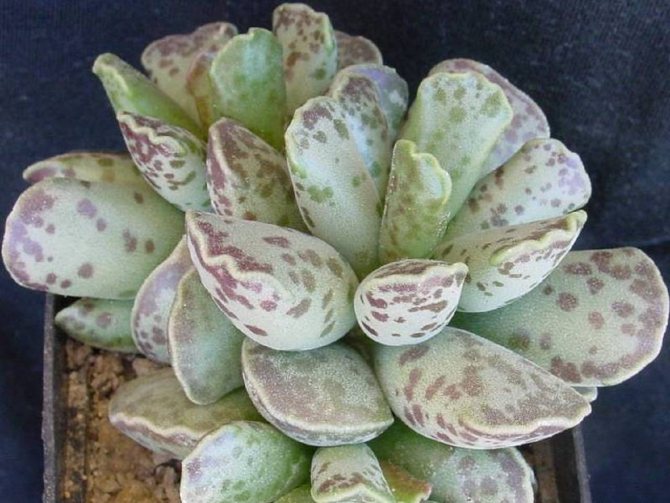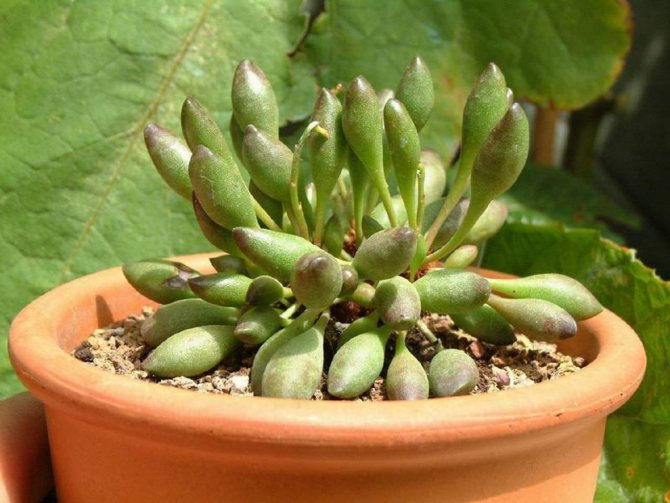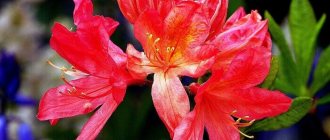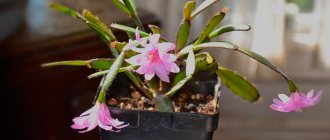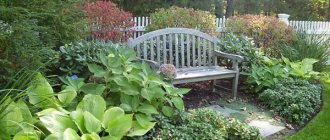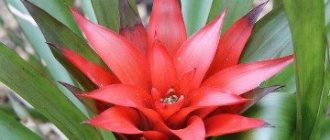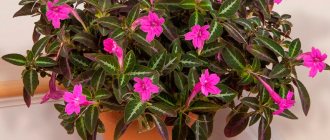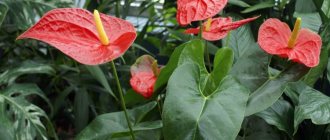About 50 species are known. It is a succulent.
Adromiscus is an outwardly unusual plant that looks not only very beautiful, but also very impressive. A decorative cactus with variegated leaves is grown in miniature pots, which are displayed not only on windowsills, but also on tables. It looks great in containers on the floor in the room, and also decorates succulent gardens. From several different species, you can create an original composition.
For those who are not yet familiar with the nuances of growing this culture, useful tips are given to cope with a rather whimsical cactus and even achieve its flowering. Also in the article you can see the names of popular types of adromiscus with photos and descriptions, which will allow you to choose the most suitable ones.
General information and types
Despite the species diversity, all adromiscus have certain similarities. For example, they are all stunted succulents. So, the height of erect shrubs does not exceed 10 cm, and of horizontal herbaceous subspecies - 15 cm. They actively branch and grow foliage.
But, nevertheless, the species are not devoid of variety and each of them has its own "zest":
- Spotted adromiscus (maculatus)
Compact, undersized, weakly branching succulent plant. The green leaf blades are round or oval, covered with graceful reddish specks, which are a real decoration.
A blooming succulent, it produces flower stalks on which reddish-brown flowers bloom.

- Comb (cristatus)
The height of the flower does not exceed 15 cm. Gradually, its branches turn into creeping shoots, which hang a little from the flowerpot. Numerous air roots appear on the stem of the cristatus.
Adromiscus comb has small leaf plates with a border, the shape is convex. It blooms with greenish-white flowers with a pink edging, the front edge of the buds is wavy. There are several varieties of crested adromiscus: clavofolius, shonlandia, zeikheri, mzimvubuensis.
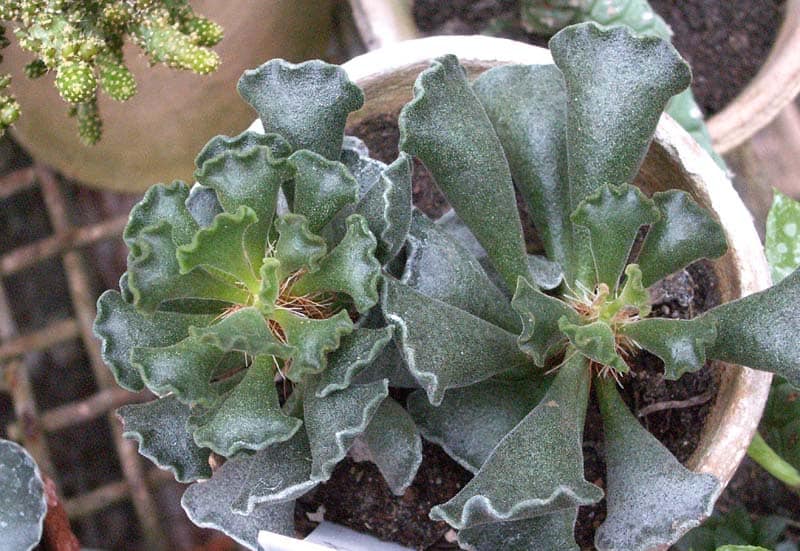

- Cooper's
Even among stunted and not particularly spreading species, Cooper's adromiscus is compact. Its stem is very strongly branched, green glossy leaves with red-brown dots. In addition to the original color, the foliage of the succulent has a very nice wavy shape. Adromiscus flowers are greenish-red, with white, purple or pink edging, form bouquets of inflorescences.
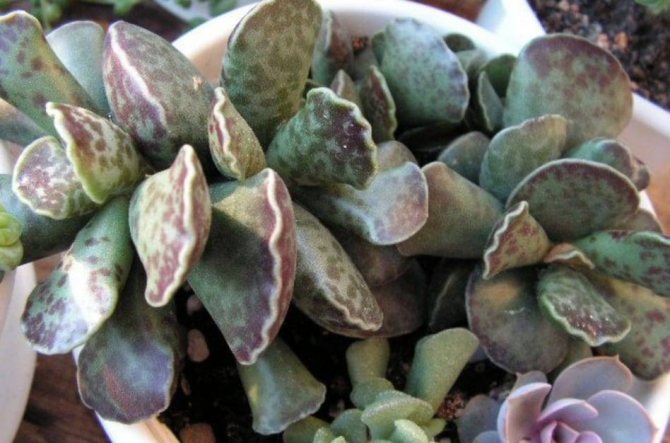

- Three-pistil
Another undersized, but weakly branching variety of adromiscus. The leaves are rounded, slightly elongated, 4–5 cm long. The color is dark green, with noticeable reddish-brown blotches, the same shades in the three-pistil adromiscus and flowers.
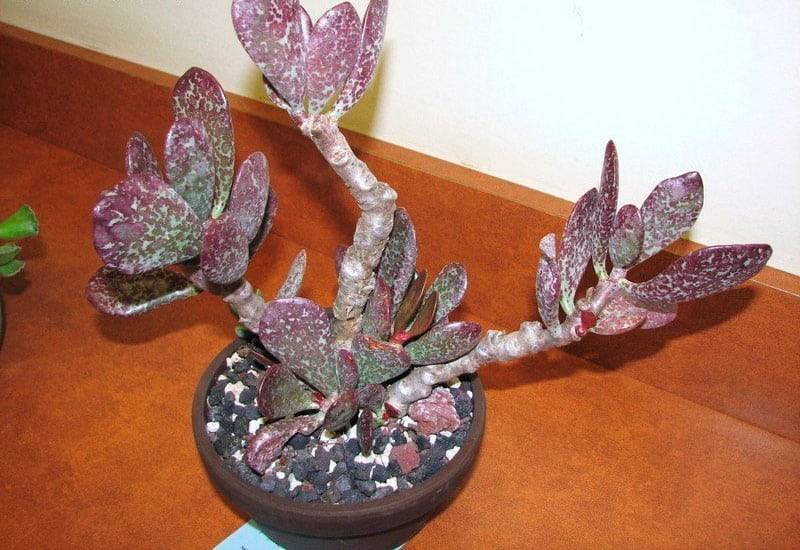

- Khalesovensis
Adromiscus with elongated triangular leaves. At the base, they taper and widen at the edges, at the end there is a pointed notch, similar to a comma. The color of the foliage is light green, shimmery with silver, the surface is glossy, there are tiny wax dots closer to the edge.
Flowers are small, solitary, reddish-green or greenish-brown in color.
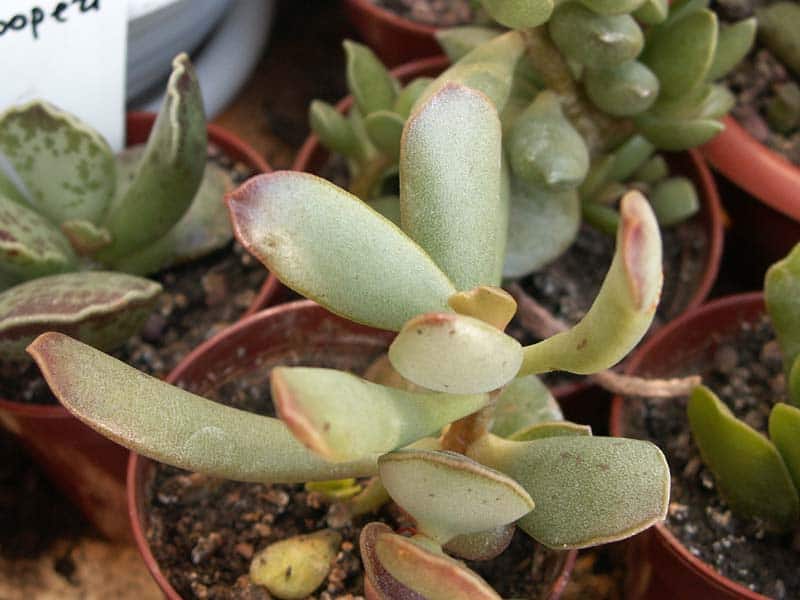

No matter how original adromiscus looks, caring for it at home will not be particularly troublesome. It is enough to take into account the special needs of all succulent plants and adhere to the rules of their cultivation.
Adromiscus Pelnitz, alveolatus, spotted, schuldinaus
Adromischus poellnitzianus - another compact variety, reaching 10 cm in height, having pale green, slightly pubescent, branching shoots, which are thick, convex in the lower part, and wider, flat above. The edges of the shoots are slightly wavy. The inflorescence reaches 30 - 40 cm, consists of several nondescript tubular flowers.
Adromischus alveolatus - a miniature bush with thick, oval shoots, pointed at the top, covered with fine hair. The color of the succulent is gray-green with a pinkish top. This variety will look interesting and extraordinary, especially against the background of small stones.
Adromischus maculatus or spotted (Adromischus maculatus) - this is a common houseplant among many gardeners, which is a compact, weakly branching bush 10 - 12 cm high.The leaves are round or broadly oval, light green, with small, brown spots on the surface, fleecy, 4 - 5 cm long, 2 - 3 wide cm.
Adromischus Schuldtianus - differs from others in the oval shape of the leaf plates, which have a pointed end and wavy edges. There is a bright burgundy stripe on the surface of the leaves.
Features of adromiscus care
This succulent is an inhabitant of the African tropics and it is natural that the climate of the apartments differs from the conditions to which the plant is accustomed. However, these flowers are highly adaptable and take root well indoors.
Temperature regime
It depends on the season:
- in summer, the temperature is considered optimal from +25 to +30 degrees;
- in winter - from +10 to +15 degrees.
Already in October, it is recommended to place the flower pot in a cool room, where it will remain until March. Thanks to this "wintering", the succulent does not lose its decorative properties, since it does not grow in conditions of insufficient lighting. And besides, keeping it cool is necessary for the flower to bloom in a timely manner.
Important! When the air temperature drops to +7 degrees and below, adromiscus may die.
How to water a succulent plant?
It is important to be careful in this matter, given that we are talking about a succulent plant and seasonality:
- in the spring-summer period - the soil is irrigated after the top layer dries up; moisture is introduced little by little, but often;
- in the autumn-winter time - the frequency of watering is reduced, during wintering in the cool it stops completely.
Water is used soft, settled, slightly warm or at room temperature.


Lighting needs
Like many succulents, direct sunlight is not dangerous for adromiscus. They tolerate such an impact well and even need it.
In winter, these flowers often suffer from a lack of light, so it is recommended to provide them with additional lighting. For these purposes, you can use both conventional and phytolamps.
Air humidity
Adromiscus spotted is picky in this matter, so there is no particular need for spraying. Even in hot weather or in winter, when the heating devices are working, you can not worry about the increase in air humidity, it is enough to wipe the leaves with a damp cloth weekly to remove dust and dirt.
Soil quality
For planting adromiscus, you can take a purchased soil mixture for cactus and succulent indoor plants. And you can also start cooking it yourself, this will require:
- 3 hours of coarse sand;
- 2 hours of ordinary land - garden or vegetable garden;
- 1h humus;
- 0.5 h. Charcoal.
All ingredients are pre-disinfected - calcined in the oven or steamed in a water bath, then cooled and mixed.
Advice! To saturate the soil with calcium, it is recommended to add a small amount of dried eggshells to it.
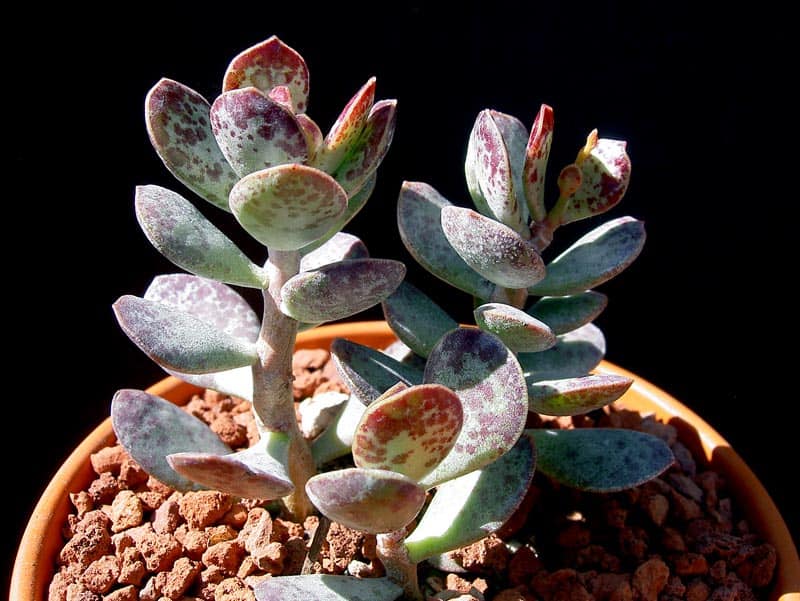

Top dressing
Succulents are fertilized only during active vegetation - from spring to late autumn; during winter dormancy, such flowers do not need feeding.
One procedure every 4 weeks is enough for Adromiscus. Complex mineral compositions with a low nitrogen content are used, which are introduced into the soil after it has been moistened.
Succulent transplant
It is recommended to replant Adromiscus every 2-3 years using a porous, breathable soil. Before the procedure, high-quality drainage should be laid on the bottom of the pot. Shallow, wide containers are suitable for the flower.
The root system of a succulent is fragile, so you need to act very carefully.
Pruning peduncles
When the flowering process of adromiscus is completed, you should give the plant a little rest and only then cut off the dried stems on which the buds were located. For this, it is better to take a sharp knife or pruner.
Reproduction of adromiscus
A new plant can be grown from cuttings or mature leaves. Often, fallen leaves give roots on their own, being on the soil. Specially, it is desirable to propagate an exotic succulent in late spring, choosing strong, healthy stems or leaves from the middle.
The planting material is left in air to dry, after which it is placed with the base to the soil surface.
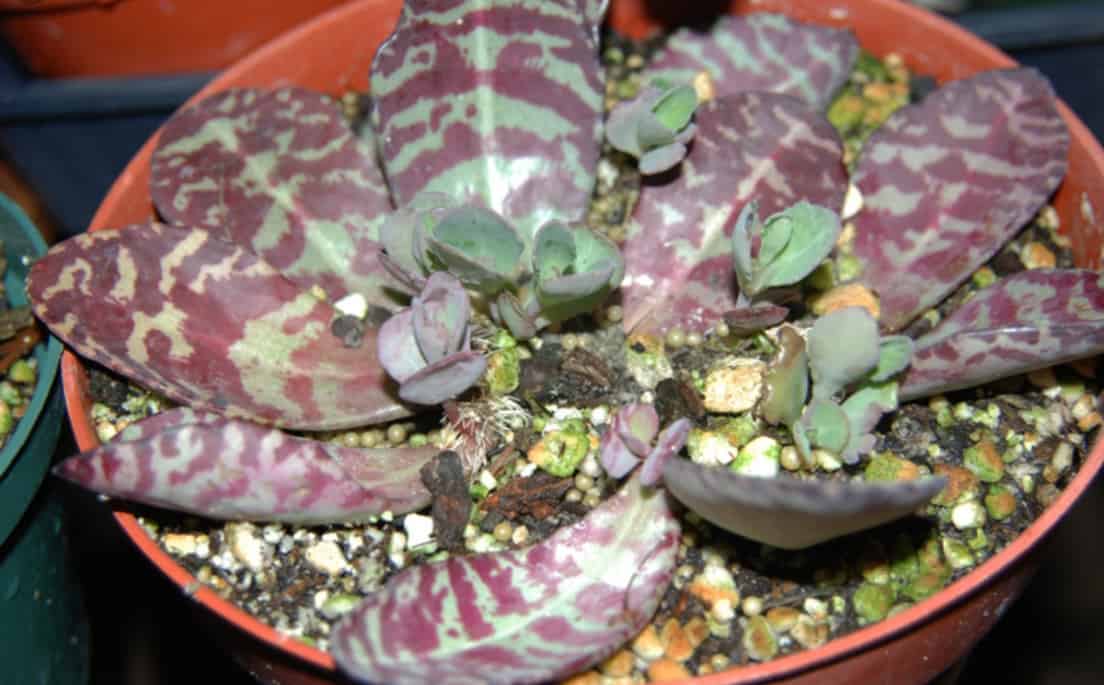

Plant propagation
The breeding process is simple. For this you will need cuttings either on purpose selected mature leaves... Even accidentally fallen leaves take root quickly due to the high moisture content.
The most suitable time for breeding is late spring. It is better to take large leaves in the middle of the stems. They can dry a little, spread on paper... Then place the base to the surface of the earth. Provide sustainability. After a while, young pagons will appear at the site of the cut of old leaves. And the planting material dries out over time.
This video shows one of the ways Adromiscus reproduces.
Diseases and pests
Adromiscus are in good health and rarely get sick, in most cases due to improper care and maintenance:
- cracking of leaves and the development of rot - mainly occurs as a result of waterlogging of the soil and stagnation of moisture in it;
- lethargy of the aerial parts of the succulent - most often occurs in weak, young, insufficiently adapted flowers to new conditions, which stand under the scorching sun.
Pest insects rarely attack African "guests", however, aphids, spider mites or mealybugs can be found on a weakened flower. They are taken out with insecticidal preparations - Confidor, Aktara or others. With a slight infection, it is enough to treat the leaves of the plant with a cotton swab soaked in soap or alcohol solution.
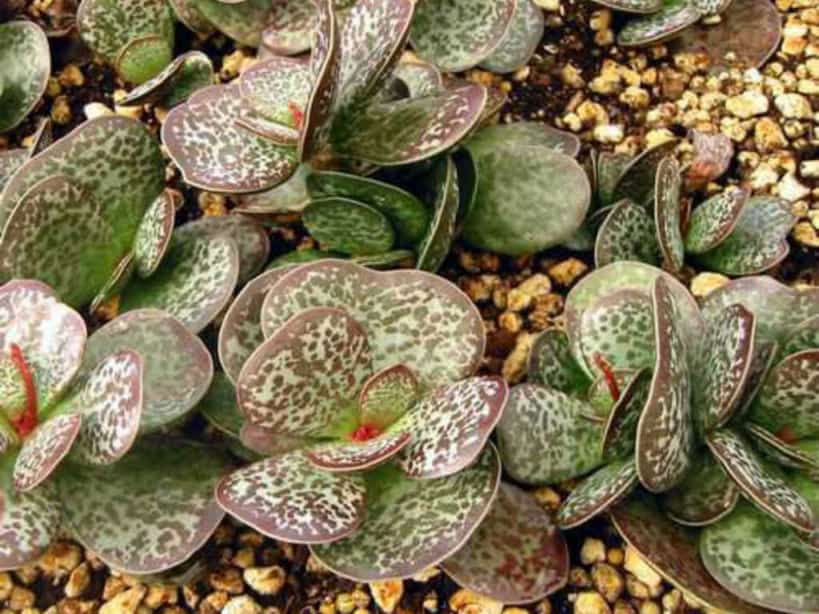

The nuances of growing
During the spring-summer period, the plant needs moderate watering. The signal to irrigate the soil in the pot is the drying of the top layer. In the fall, watering activities are reduced. In frosty time, the procedure should be completely stopped. The use of soft water (settled) with room temperature is encouraged.


Adroimskus is fed monthly throughout the warm season (March - September). To this end, growers practice the use of a commercially available nutrient mixture intended for cacti. During the rest period, feeding procedures must be stopped.
Attention! Pruning adromiscus at home is not needed.
The transplant event takes place in the spring. It should be done only when there is a serious need to change the flowerpot, soil. The priority is the use of small pots. At the bottom of the planter, you will need to lay a layer of drainage.
For plant propagation, leaf cuttings are most often used. The planting material is separated from the parent specimen and left to dry in a shaded place for several hours. Further, the cuttings are determined in compact containers filled with a mixture of vermiculite, river sand (coarse-grained). It will take about 4 weeks for rooting, after which young specimens will begin to grow actively (they do not need special care that differs from the standard).
Attention! The use of seeds for propagation of adromiscus is the prerogative of experienced florists due to the laboriousness of the process.
Home care for adromiscus


Illumination
Needs bright light, while the direct rays of the sun are not terrible for such a plant.
Temperature regime
In the summer, it needs warmth, so a suitable temperature regime is from 25 to 30 degrees. And in winter time it needs to be placed in a cool place (about 10-15 degrees). Make sure that the temperature in the room does not drop below 7 degrees. In the event that the room is excessively hot, ventilation should be significantly increased.
Humidity
Adromiscus does not need to increase the humidity of the air and does not need to humidify it from the sprayer.
How to water
In the spring and summer, watering should be moderate. So, this succulent is recommended to be watered after the soil in the pot dries out completely. With the onset of the autumn period, you need to water less. In winter, there should be very rare watering, or you can resort to dry content (depending on the selected temperature regime). It should be watered with soft water, which must be at room temperature.
Top dressing
They feed from March to September once every 4 weeks. For this, special fertilizers are used for cacti and succulents.
Transplant features
The transplant is carried out in the spring and only if absolutely necessary. They choose small pots for planting. The soil can be purchased ready-made in the store, designed for succulents and cacti. Make a good drainage layer at the bottom of the container.
Reproduction methods
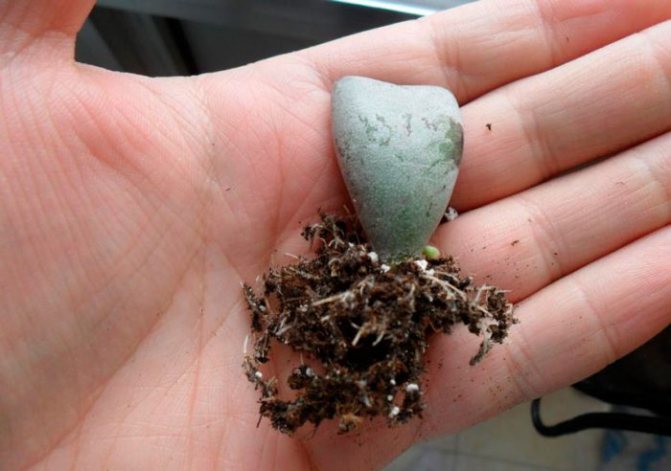

Propagated in spring by leafy cuttings.
The separated leaves are left in a dark, dry place to dry for several hours. After that, they are planted in small pots filled with vermiculite or coarse river sand. Cactus soil mixed with sand is also suitable for planting. The cutting should take root after 4 weeks.
Pests and diseases
Aphids, spider mites and mealybugs can settle on the plant.
Possible problems
- the lower leaves turn yellow and die off - the natural aging process of the flower;
- rot appeared - liquid has entered the leaf outlet;
- yellowing and drying of foliage - sunburn, overflow;
- leaf plates are cracking - the soil is very dry;
- elongated shoots, loose faded leaves - poor lighting.
Adromiscus Marianne, festivalus, Zeyera, Halesovensis
Adromischus Marianae - the most spectacular type of this culture, which will be appreciated by fans of original plants. It is a compact shrub 7-10 cm high with small, rounded, slightly elongated leaves that have a pointed end. Shades of leaf plates can vary from dark green to deep burgundy. One bush can combine several different colors, which makes it not only unusual, but also very attractive. This variety shows its decorative effect only in bright light. In the shadows it grows inconspicuous.
Adromischus festivus or refined (Adromischus festivus) - a small succulent with elongated thick leaves on short stalks. The upper part of the leaf plate is more convex and has a wavy edge. The surface of the leaves is gray-green with dark green specks.
Adromischus halesowensis - a variety with thin, elongated, convex leaves.The top of the leaf is slightly wider than the bottom and is slightly flattened. The color of the leaves depends on the lighting. They can be light yellow, light green, or dark green. A thin, bright border runs along the edge of the leaf plates.
Adromischus zeyheri - has elongated, fleshy, smooth triangular leaves with rounding in the upper part. The color of the leaf blades is light green with brown or burgundy specks. Peduncle 30 - 50 cm long. The flowers are tubular, white.
Main types
Adromiscus cristate (Adromischus cristatus)
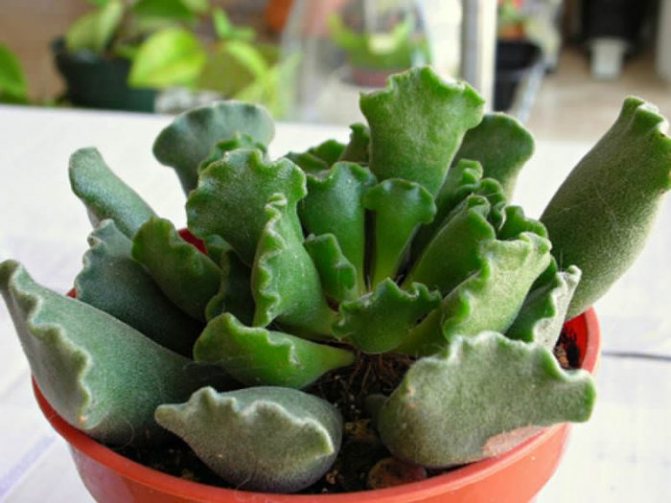

This compact succulent plant does not exceed 15 centimeters in height. Young shoots are erect, and with age they become hanging or creeping, and a large number of reddish aerial roots are located on them. Pubescent, convex, short-petiolized leaves are collected in rosettes. Dark green leaf plates have a wavy edge. In width, they reach 5 centimeters, and such leaves have a centimeter thick. The greenish-white flowers have pink edging.
Adromischus cooperi
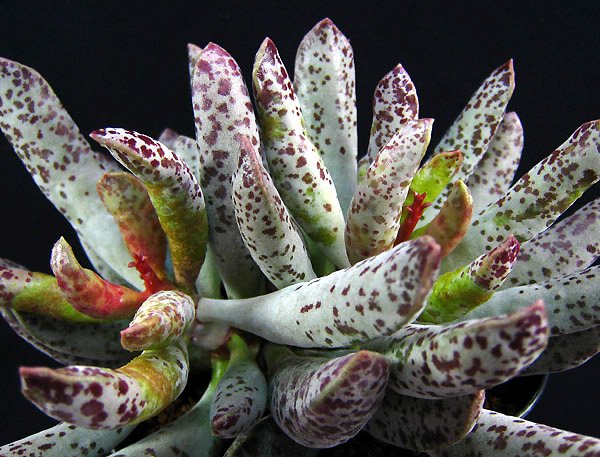

It is also a compact succulent plant whose stem is not only very short but also branching. Green, oval, glossy leaves have brownish-red spots on the surface. The edges of the leaves are wavy, and in length they can reach 5 centimeters. The long inflorescence is spike-shaped. Tubular greenish-red flowers reach 1.5 centimeters in length and have pink, white or purple edging.
Adromischus poellnitzianus


This miniature succulent plant does not exceed 10 centimeters in height. The pale green shoots branching from the base are convex and smooth in the lower part, while they gradually expand upward and turn into a flattened wide part with a wavy edge. On the surface there are poorly distinguishable whitish hairs. On an inflorescence of forty centimeters in length, there are not very attractive flowers.
Spotted Adromischus (Adromischus maculatus)
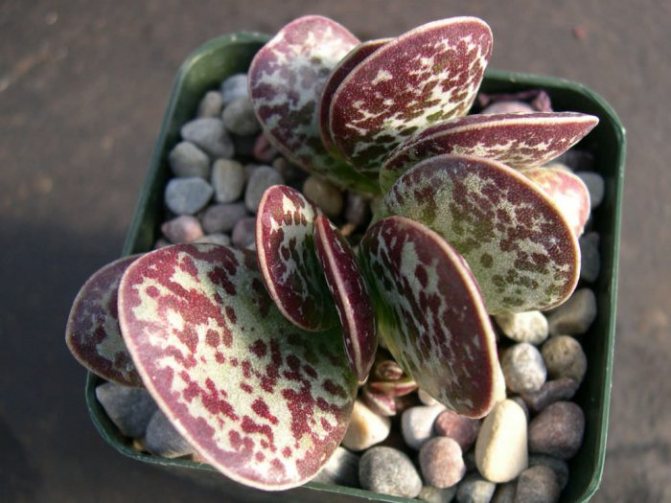

These are weakly branching small succulents that reach a height of only 10 centimeters. There are red spots on the surface of the dark green leaves. A leaf plate of an oval or round shape can be up to 5 centimeters long and 3 centimeters wide. The color of the flowers is brownish red.
Adromischus - a succulent plant belonging to the Crassulaceae family. The homeland of Adromiscus is South and Southwest Africa. Genus name "Adromischus " comes from two Greek words "adros" - thick and "mischos" - trunk. Indeed, looking at this small plant, not only its plump juicy leaves, but also a dense stocky trunk, are striking.
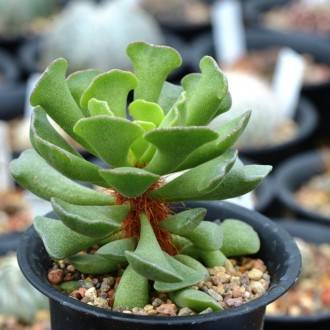

Adromischus description.
Adromiscus - undersized (3-5 cm tall) shrubs or perennial herbaceous plants with a short recumbent stem. The stem of some species is covered with brownish-red aerial roots. The leaves are juicy, fleshy, sometimes brightly colored and pubescent. Most often, Adromiscus leaves are round or triangular in shape. The inflorescence is spicate, on a long peduncle. The flowers consist of five petals fused together into a narrow tube. The flowers of Adromiscus are most often white or pink. In Moscow, even in the winter garden, it blooms with difficulty, if only it turned out to be a truly sunny summer. At home, it blooms even less often.
Adromischus species.
Adromischus marianae herrei - incredibly beautiful plants with textured red leaves that look like pieces of lava or tuff. It grows very slowly, requires the greatest amount of sunlight you can give it. Without enough light, it loses its bright color, turns green, can stretch out and lose all its beauty and compactness.
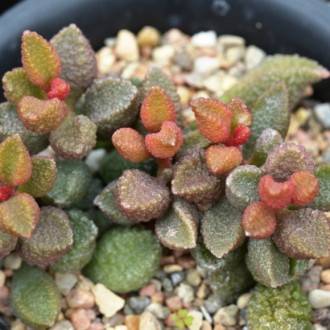

All lovers of succulents hunt for Adromischus marianae herrei and it is always in short supply, this plant is so beautiful and attractive.
If you take a closer look at this species, you can find that there are a lot of subspecies, which differ in the shape, size and brightness of the leaves, as well as the growth rate, and, accordingly, the price. So far, there are only two subspecies of Adromischus marianae herrei in my collection of succulents. The first with small, club-shaped red leaves, it even bloomed.


The second variety, Adromischus marianae herrei, has large, textured leaves. It grows extremely slowly. But it's nice that it grows from a leaf cutting, and is already quite a sizeable size for Adromiscus!
Adromischus cooperi - the easiest and most common type. It is found in almost every collection of succulents, it is interesting with leaves with brown specks.


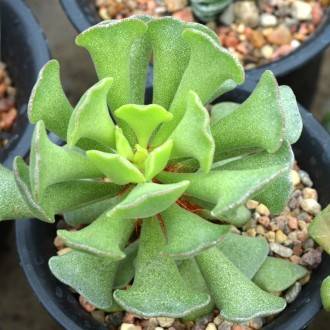

Adromiscus cristate (Adromischus cristatus) - also a very common species with wavy leaves. The view seems to be common and simple, but only at first glance. Growing a compact specimen with dense leaves is not so easy, try it yourself!
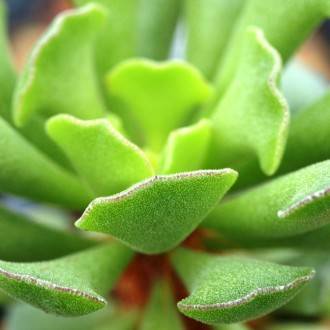

Botanical characteristics of adromiscus
| Genus | Adromiscus |
| Family | Fatty |
| Homeland | South and South West Africa |
| Escape type | Straight or creeping |
| Inflorescence | Ear |
| Petal color | Hot pink, purple, white |
| The structure and color of the leaves | Rounded or rounded oval, variegated or light green |
| Flowering period | Throughout the year |
| Fetus | Achene |
| Reproduction | Dividing the bush, seeds, cuttings |
According to botanical characteristics, adromischus (adromischus) is a shrub or perennial herb with straight shoots no more than 15 cm high. Most often there are undersized species reaching 10 cm. In some species, the shoots are flexible, creeping.
Stems along their entire length are covered with small thin aerial roots of a reddish or brown hue. Thanks to this arrangement of the roots, the plant receives moisture and valuable substances from oxygen.
The leaves of the succulent adromiscus are round or rounded-oval, fleshy, variegated or monochromatic light green, may have a lilac or silver tint. Their length is 5 - 6 cm, thickness - 1 cm. Attached to the shoot with a short, thick root. Leaf plates of some species have light pubescence on the surface.
The peduncle of this culture is quite long, reaching 25 cm. In its upper part, an inflorescence is formed - an ear. The flowers are five-petal, white, purple or bright pink. Corolla petals grow together to form a narrow tube. Flowering can be observed several times a year.
Types, description, origin
Adromiscus are small shrubs or herbaceous plants with alternating succulent leaves of a wide variety of shapes. Leaves can be of all shades of green or pink. And they are often painted with numerous bright spots of irregular outlines.
Flowers are small tubular, usually white or pink, collected in erect or drooping inflorescences - do not attract much attention. However, it is quite difficult to achieve flowering in the middle lane and is possible only on the southern windowsill, if the summer is really sunny.
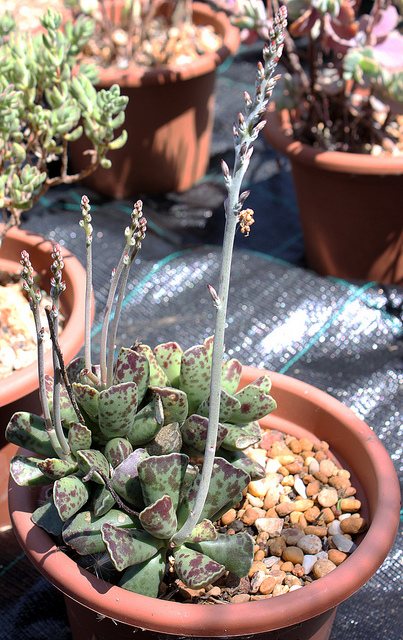

Blooming adromiscus cooper.
Like most succulents, adromiscus comes from the southern regions of the African continent. There he lives in crevices of stones, in deserts, and often climbs mountain slopes.
About 60 species are known, among which plants with bright crimson and pink spots on the leaves are especially popular. True, if plants spend most of their life in insufficient light, this beauty can disappear and the adromiscus will become uniformly green.
The most common species among amateurs are:
- Cooper's adromiscus (A.coopperi)
- Crested adromiscus (A.cristatus)
- Adromiscus spotted (A.maculates)
- Trigunus adromiscus (A.trigunus)
- Adromiscus schuldianus (A.schuldtianus)


The variety of types of adromiscus.
What houseplants do this flower look like?
- Eonium bears a general resemblance to adromiscus. They both belong to the jumbo family, and both are herbaceous succulents. Aeonium also often has aerial roots. The leaves are similar in appearance.
- Pachyphytum is a succulent from the fatty family. Like adromiscus, it has a short stem with succulent leaves. The peduncle is often white and pink.
- Aichrizon belongs to the same family. The foliage is painted in bright green shades. This plant comes from warm countries. Some types of adromiscus outwardly resemble aichrizon.
- Stone rose from the same family as adromiscus. The leaves of these representatives of succulents are juicy and fleshy, colored in various shades of green. They are characterized by resistance to weather conditions and drought resistance.
Conditions of detention and care
As for light, Adromiscus always lacks it. He loves direct sunlight and the best place to grow it is south-facing windows. Elsewhere, the plant may survive, but the color of the leaves will noticeably fade.
He is not picky about temperature. In summer, it can reach + 30 ° С. The only mandatory requirement is to ventilate the room if it gets too hot. In the fresh air in summer, adromiscus will feel great. In winter, it is advisable to provide him with peace, keeping in a bright and cool place with temperatures up to + 5 ° C. Watering with this content is completely excluded. If this is not possible, and adromiscus is forced to stay in normal indoor conditions in winter, then it will be enough to choose a cooler place for it, and water it once a month.
This succulent perfectly tolerates indoor air dryness, so you don't need to worry about any additional measures in this regard. Although in a greenhouse, the plant grows overgrown with impressive aerial roots.
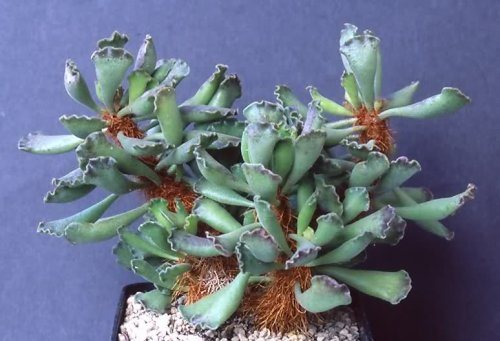

Aerial roots grown in high humidity conditions.
Watering adromiscus even in summer should be very sparing, observing the soil surface in intervals, so that it has time to dry out. On average, the frequency of watering can be once every 10 - 15 days. Underfilling is always better than overfilling. It is advisable to take soft rainwater and not cold water for irrigation.
Growing a houseplant adromiscus
Adromiscus cannot be called a whimsical culture, however, in order to grow a beautiful and healthy succulent, you need to create suitable conditions for it. The most important thing for a southern visitor is to provide him with good lighting all year round. The peculiarities of growing this peculiar outwardly plant will be discussed below.
Temperature. This culture feels comfortable at temperatures from 22 degrees and above. It grows well and develops in extreme heat throughout the summer season. In the middle of autumn, the conditions for adromiscus should be changed, placing it in a cooler place with a temperature of 12-16 degrees, where it should stay for a couple of months. A change in temperature makes the succulent stronger, stronger, and also contributes to abundant flowering in the future.
Constant stay in a warm room, on the other hand, weakens the plant and makes it impossible for flowers to form.
Lighting. Providing a flower with bright, long-lasting lighting is a guarantee of a healthy, fast-growing plant. The most optimal place for him is the window sill on the south side of the apartment, where direct sunlight often falls. They will not only not harm the succulent, but, on the contrary, will accelerate its growth, make the color more intense. Daylight hours for this culture should last for 8 hours. In winter, in order to satisfy the need for long-term illumination of the cactus, daytime lamps are installed near it.
Watering. When caring for adromiscus at home, you need to take into account that watering should be moderate, you should wait until the soil dries out to re-moisten it.Moisture accumulates in the leaves of the succulent, so it can easily endure even prolonged drought, while too frequent watering can lead to rotting of the plant.
During the dormant period, it is enough to moisten the soil once a month.
For the health of the root system, the prevention of its various diseases, it is recommended to defend water before irrigation, or, if possible, use rainwater.
Humidity. A succulent plant reacts negatively to high humidity, so no spraying is required during its cultivation.
The soil. For planting adromiscus, ready-made cactus soil, which can be purchased at a flower shop, is suitable. Experienced gardeners prepare the soil mixture on their own by mixing garden or leaf soil with humus, coarse sand and charcoal, taken in a ratio of 2: 2: 3: 1. Such soil has all the necessary properties required for a given plant. It is rather loose, does not retain moisture and oxygen, providing them with easy access to the root system. Before planting, it is necessary to lay a drainage layer in the form of pebbles, expanded clay or other material on the bottom of the pot.
Top dressing. Adromiscus does not need frequent feeding. The plant consumes nutrients very slowly. It is enough to apply fertilizer once a month using mineral complexes for succulents. During the dormant period, feeding is not needed.
Transfer. The transplant is carried out in several cases. It is necessary if the plant is purchased in a store, but then it must adapt in a new place within 2 - 3 weeks. During this time, you should not bother him. The second case when a transplant is needed is the growth of a bush, when it becomes cramped in a pot. The third case is succulent disease.
The new container for adromiscus should be 2 cm wider than the previous one. The pot should be wide, but not deep, always with drainage holes. The transplant is carried out by the transshipment method with the preservation of a clod of earth. The plant is carefully placed from the old pot into a new one. The missing amount of soil is filled up, the surface is tamped, then watered.
Another care. After the plant has faded, inexperienced gardeners make a mistake - they immediately remove the peduncle with faded buds. This does not need to be done for 20 days, since the cactus is already weakened and bacteria can quickly infect it. After the specified period, you need to carefully cut off the leg, treat the cut with charcoal.
Diseases and pests. Diseases rarely affect this plant. Most often this happens due to improper care of the succulent. Excessive watering leads to stagnation of moisture and, as a result, decay of the root system.
As a result of prolonged heat and lack of moisture, the bush loses its bright color, the leaves become faded, wither. In summer, adromiscus can suffer from the scorching rays of the sun if exposed to them for a long time.
Sometimes the plant is affected by thrips, aphids and other harmful insects. If a light bloom is found on a cactus, it should be immediately treated with an insecticide solution. Repeat the treatment after 14 days.
Transplant, nutrition and reproduction
A feature of the species is its slow growth, therefore adromiscus is transplanted in spring, usually every two, or even three years.
A ready-made mixture for cacti and succulents is usually used. But if you wish, you can make it yourself. For this, half of the leaf land is taken, mixed with half of the coarse-grained river sand, charcoal and brick chips are added. It is important to fill the pot with a good layer of drainage before planting.
For growth and development, adromiscus is recommended to be fed once a month, but only from April to September. In other months, you don't have to worry about feeding.
Propagate, like most succulents, stem or leaf cuttings.
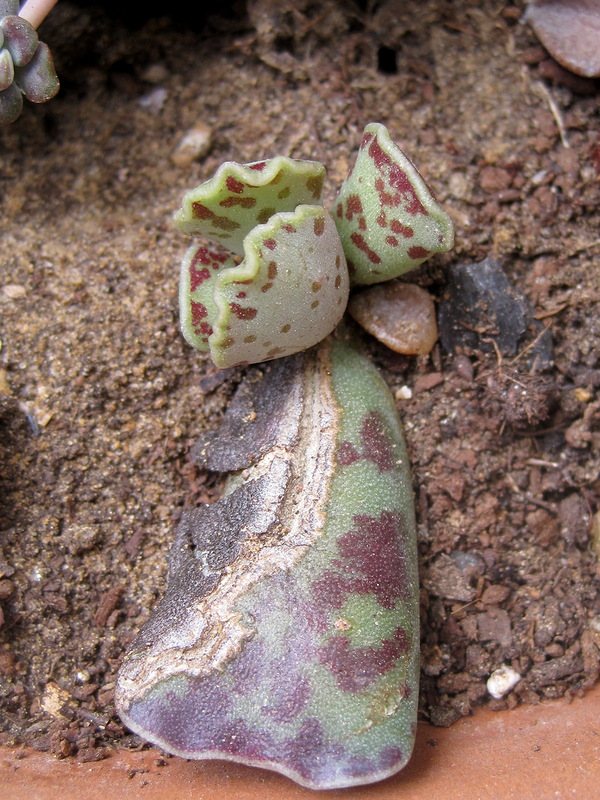

A baby that grew out of a leaf.
It should be noted that the original pattern on the mother leaves is not always preserved when propagated by leaves, in these cases it is safer to use pieces of the stem.
Reproduction of the cactus adromiscus by dividing the bush
This method of reproduction of a cactus is advisable to use during the growing season. It should be noted that the root system of this plant can quickly rot, therefore, during the procedure, it is necessary to maintain sterility, that is, use only clean instruments.
First, a part of the root is carefully cut off, which is either dried for 2 hours, or the cut is treated with charcoal. For planting, take a loose, light, nutritious soil, in which a deepening is made and the root is placed there. From above it is sprinkled with a layer of earth, irrigated. Watering should be done systematically as the soil dries out, but it is important to avoid excess moisture in the container. The container is kept in a warm, bright place. In good conditions, the root will grow back quickly and sprout.
Growing conditions
Illumination
Bright lighting is needed to preserve the valuable leaf spot. Place a flowerpot with adromiscus on the southern windowsill, but during the summer noon hours it is advisable to shade it with a sheet of paper or half-covered blinds. Grows well on east or west windows. On the north side it suffers from a lack of light, especially in winter.
Air temperature
It needs warmth in spring and summer, grows normally in a temperature range of 25-30 ° C. At higher rates, ventilate the room more often, if possible, move it to fresh air (on the veranda, balcony, in the garden). Wintering is preferable cool, so that the adromiscus accumulates strength. Maintain the temperature between 10-15 ° C, but the mark should not drop below 7 ° C.
Are there views?
The genus Adromiscus includes about 70 species. Plants have a varied color from light white to purple interspersed. They differ in their size and shape. So, in adromiscus three-pistil one of the largest leaves, reaching 6 centimeters. This species is also considered the most beautiful.
Each species has its own habitat. Some grow only in South Africa, while others are common throughout its territory.
The most famous plants: adromiscus comb, Cooper's adromiscus, spotted adromiscus, three-pistil adromiscus, Pelnitz's adromiscus.
How to care for adromiscus at home


Watering
Water the succulent adromiscus regularly, but in moderation, throughout the spring-summer period. Between procedures, the earthen lump should dry out by half. From autumn, watering is reduced, in winter they are kept completely dry, subject to a decrease in temperature. Use softened water - rainwater, after the ice melts, filtered or settled for at least a day, tap water, always at room temperature.
Such plants are adapted to store moisture, so they feel great when the air in the room is dry. No need to spray the plant or take other measures to maintain moisture levels.
Top dressing
From March to October, adromiscus needs additional feeding. Buy special fertilizers for succulents at a flower shop and apply once every 4 weeks.
How to grow adromiscus from seeds
If the florist is engaged in the cultivation of this culture for the first time, in this case the seed is used. The seeds can be purchased from a specialist store. For those who do not know how to successfully grow a succulent plant using seeds, see the information below.
For sowing, prepare a small container with holes to prevent stagnation of water, which is filled with soil for succulents. Seeds of adromiscus are evenly scattered over the surface of the earth, covered with a small layer of sand on top. Sand can be replaced with small pebbles. Crops are sprayed from a spray bottle. The container is tightly covered with a film and taken to a room with a temperature of 20 - 25 degrees. Seeds sprout in 10 to 15 days. After that, the film is removed. When the grown plants become stronger and larger, they are transplanted into separate pots.
Adromiscus transplant
Adromiscus transplant is carried out in early spring before the start of a new growing season.Do this as needed - when the roots begin to protrude through the drainage holes or the top grows.
Choose a pot that is wide and shallow, lay a layer of drainage on the bottom (expanded clay, pebbles, broken brick, pieces of foam plastic, small gravel, etc.) in a layer up to ¼ of the total volume.
The soil needs light, loose, well-permeable to water and air. Take as a basis the universal soil for succulents and cacti, add pieces of charcoal and coarse sand to it. Pass along with an earthen lump, after transplanting, water a little bit so that the roots do not start to rot.
Transfer
A transplant is required once every couple of years. It is carried out in the spring, after the dormant period of the plant. It is necessary to change the pot to a new container when the size of the bush exceeds the size of the container, that is, as needed. The new pot should not be bulky, since the roots of the adromiscus are small. There must be holes at the bottom of the container for water drainage.
You need a loose land with good drainage. A lot of sand and crushed charcoal are added to it. Excellent soil for succulents. Self-soil mixture is prepared from two parts of humus, two parts of garden soil and three parts of sand. The transplant procedure is as follows:
- A few days before transplanting, it is recommended not to water the flower.
- It must be pulled out carefully, without damaging the roots.
- At the bottom of the new container, stones must be laid out as drainage.
- After that, you can cover it with soil on top.
- During planting, the stem should not be deepened too deep, otherwise the plant may rot.
After completing the entire process, adromiscus should in no case be watered for the next several days.
Reproduction of adromiscus at home
In room conditions, adromiscus is propagated vegetatively:
- In late spring or early summer, separate a leafy cutting from the bush.
- Wait until the cut site is covered with a film and plant in the soil - clean wet sand or vermiculite can be rooted in a universal substrate for succulents with the addition of coarse sand.
- Maintain ambient lighting and air temperature between 20-22 ° C, water sparingly, and keep away from drafts.
- After about a month, the seedling will grow and it can be transferred into a pot with a diameter of 5-7 cm with soil, as for an adult adromiscus.
Reproduction of adromiscus by leaf cuttings
This flower is easily propagated by leafy cuttings, seeds and bush division.
Reproduction of a cactus by leaf cuttings is carried out in the spring. This method has its own advantages and disadvantages. The root system grows for a new plant for a long time. It will not be possible to transplant it into a new pot immediately, but after 1 - 2 months or more. Many growers prefer to propagate adromiscus with a leaf, because this method does not require time and effort.
To do this, an intact, perfectly healthy, medium or large leaf is chosen from an adult plant, carefully cut off with a sharp, clean knife and removed for a couple of days in a dry place so that the cut point at the cutting dries up. After that, it is planted in a soil mixture for cacti to a depth of 1 - 2 cm, covered with a jar or polyethylene. The stalk is ventilated daily, watered as the soil dries. When the first leaves begin to grow on the handle, the shelter is completely removed. The container with the plant is stored in a warm, lighted place, but away from direct sunlight. The rooting of cuttings of adromiscus can be observed a month after planting, and when the young cactus gets stronger, it is placed together with a lump of earth in a pot where it will grow.
Diseases and pests
Adromiscus is resistant to diseases, but a number of difficulties are possible with improper care:
- Rot has appeared on the leaves - perhaps when watering, drops of water fell on the leaf plates, you need to be careful. Cut off the affected areas and treat the plant with a fungicide;
- Root rot - the cause is waterlogging of the soil and dampness. It is better to skip watering once again so as not to destroy the plant. When wintering cool, do not keep in a damp place. We will save the plant with an emergency transplant. We cut off the rotten areas of the roots, treat healthy places with a fungicide and transfer the succulent into a disinfected pot with fresh soil mixture;
- Yellow spots appear on the leaves - the consequences of sunburn, shade the plant on a hot afternoon;
- The shoots are elongated, the leaves are loose, faded - insufficient lighting;
- Leaves are cracking - the plant does not have enough moisture in the soil;
- The lower leaves turn yellow and dry - this is a normal phenomenon, there is no reason for concern.
Pests rarely appear, among them:
- Aphids are small yellow, greenish or gray insects that feed on plant sap. They settle on the back of the leaves and are visible to the naked eye;
- Mealybug - a worm in a cotton-like pubescence, leaves the same discharge;
- Spider mite - rounded reddish bugs that are not visible to the eye, but betray themselves by weaving cobwebs on the plant.
How to deal with pests of adromiscus? First of all, they are removed mechanically: moisten a cotton pad with ethyl alcohol or a solution of laundry soap and wipe the stems and leaves. Then you can resort to folk methods of struggle by sprinkling with a solution of infusion of garlic, onion peels, wormwood or other intensely smelling herbs. An extreme option is treatment with an insecticidal preparation (Fitoverm, Aktellik, Neoron).
Unpretentious succulent
The succulent adromiscus belongs to the huge Tolstyankov family, is a perennial undersized shrub. The homeland of the plant is the territory of Africa (South Africa, Namibia). Adromiscus likes sandy mountain formations, slopes, ravines. At home, the succulent feels very good, it is considered unpretentious. Even a novice florist can cope with the cultivation of such a culture.
Adromiscus is a plant with a short trunk maximum 15 cm high. Its crown is formed by succulent leaves. The shape, color of the foliage can be different, it all depends on the specific species. As a rule, the plant has thick leaves that expand at the base, tapering towards the ends. There are also specimens with corrugated sheets with a rough surface. The colors of the plates include the entire palette of green, as well as purple and gray shades.


Adromiscus produces tubular buds. The petals can be white, pink. The purple coloration is considered to be quite rare. The diameter of the buds is about 2 cm. They are attached to the peduncles (25 ... 40 cm long) with the help of short pedicels.
Attention! Adromiscus is characterized by a developed rhizome. Some varieties tend to form aerial roots that can cover the surface of the stem.
Types of adromiscus with photos and descriptions
In nature, there are about 70 species of these wonderful plants, in culture the most interesting in terms of decorativeness.
Adromiscus cristate Adromischus cristatus


A compact bush with a height of about 15 cm. At first, the shoots are erect, but over time they droop. The basal rosette is formed by fleshy leaves (about 1 cm thick) with wavy edges, the leaf length is about 6 cm. The color is monochromatic, dark green. Corollas are white-green with pinkish edging.
Description: Adromischus cristatus (cristate adromischus) is an exquisite dwarf succulent plant with multiple rosettes formed by thick, back triangular leaves, with a felt texture and characteristic wavy, wavy peripheral leaf margins.This is a special species that can hardly be confused with others. It is also easily recognizable by its short stem wrapped in a thick layer of reddish, tangled, hairy aerial roots. The species is very changeable. Roots: fibrous. Stems: straight, 2-5 (-8) cm tall, with fibrous roots at the base and glandular hairs on the stem. Leaves: 1.5-5 cm long, 5-20 mm wide, swollen, with inverted triangles to oblong-elliptical, triple or somewhat compressed, from green to gray-green in color, the tip is shortened or rounded to more or less widened, the base of the petioles is somewhat wedge-shaped. The edge in the upper half of the leaf is horny, wavy, often darker. Sometimes covered with glandular hairs, usually glabrous or glabrous, green or gray-green, often with darker markings. Inflorescence: spike-shaped, 10-20 cm high, gray-green. Flowers: buds are tubular, slightly grooved, gradually tapering towards the tip, straight at first, then widening. Flowers 1-1.2 cm, calyx 1.5-3 mm long, gray-green, petals 2-1.5 mm wide, ovoid-triangular, sharp, white with a pink tint, with a darker edge, opening or curved , coarse, with hairs, mainly in the throat. Anthers 0.6-0.9 mm long, not protruding from the rim. Pedicels are 1-2 mm long.
Adromischus cooperi
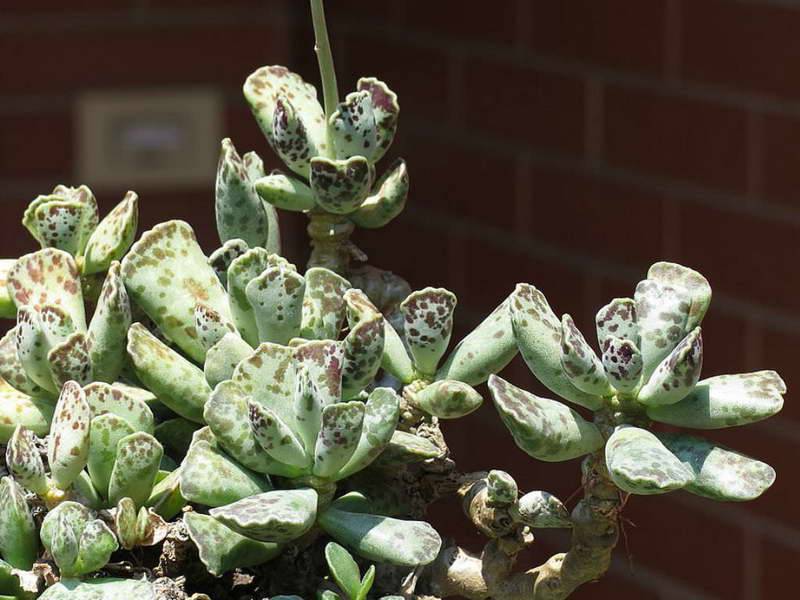

The plant has well-branched short stems and oblong leaf plates. At the base, the leaves are narrower, then thickened, the top is sharp. The skin is light green with a whitish bloom and burgundy specks. The green-red flower tubes are decorated with pinkish or purple piping.
Description: Adromischus cooperi is a dwarf, freely branching perennial succulent 2-7 cm high and 15 cm wide.Its leaves are larger than those of Adromischus cristatus, plump, tapering to the base, pale silver-gray with a shade of green and elegantly decorated dark purple spots. Stems: short, spreading, sometimes greyish brown with aerial roots. Leaves: dissected, tubular or obversely spear-shaped at the end, ovoid, triangular, wider than the leaf, with white, slightly wavy horny leaf margins, 2.5-5 cm long, glossy, gray-green to blue , hairless, distinctly spotted on the upper surface, with large purple markings. Inflorescences: 35 cm and more. Flowers: Tubular, green-red, densely coated, with white edges, pink or purple petals and clavate hairs in the throat and on the corolla. Bloom season: summer. Fruit: Dry capsule.
Adromischus Pelnitsa or Pelnitzianus Adromischus poellnitzianus
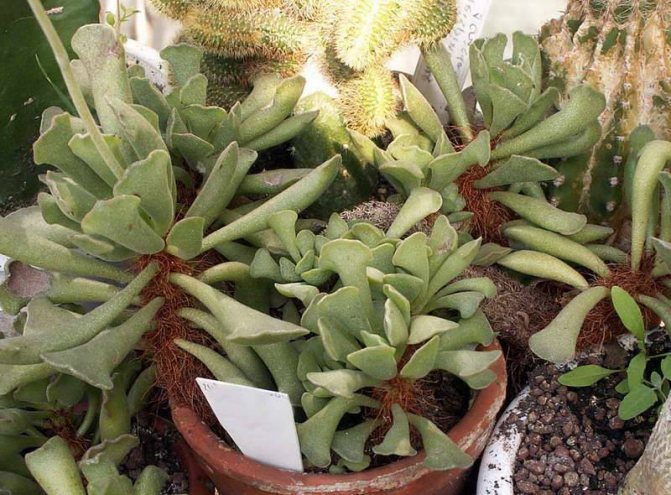

The bush is only 10 cm high. It resembles a palm tree: the stems are elongated, thanks to the airy roots, fluffy, reddish-brown shade. At the top is a rosette of lobed leaves, they are fleshy with rounded tops. The length of the flowering stem is 40 cm, the corollas are greenish.
Adromiscus spotted or maculatus Adromischus maculatus
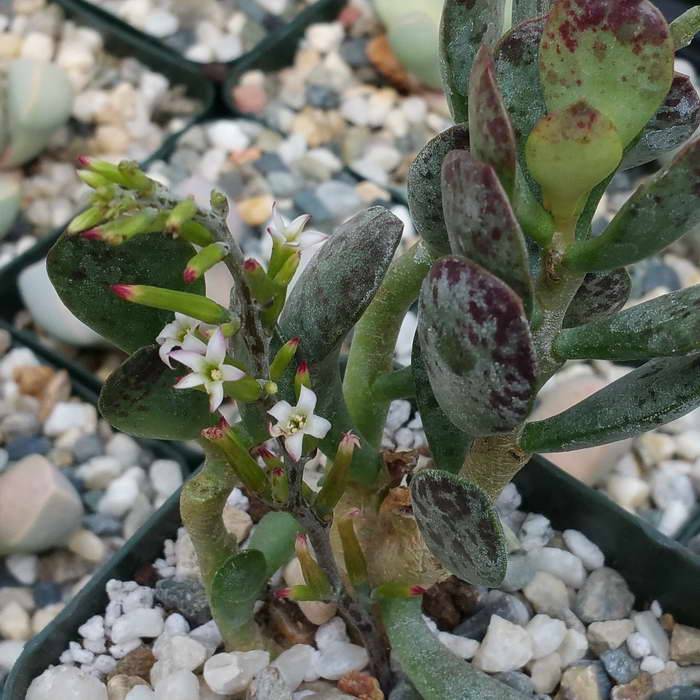

It branches weakly, the plant reaches a height of no more than 10 cm. The leaf plates are oval or round, 5 cm long, about 4 cm wide, dark green with burgundy specks. This species has flowers of a red-brown hue.
Description: Adromischus maculatus a.k.a. The "Chocolate Drop" is a pleasant succulent with rather flat wedge-shaped leaves, albeit thick ones, which are beautifully marked with a chocolate color giving them a marbled appearance. Form: low-growing perennials, succulent leaves forming small clusters or clumps. Roots: fibrous. Stem: very short, somewhat arboreal, prone to striking up to 15 cm long, slightly branched. Leaves: obovate, scapular or obovate, flattened, blunt tip and often pointed or serrated, (25-) 30-70 (-100) x (15-) 20-35 (-40) mm, round, usually sharply wedge-shaped, with a horny edge all over the leaf, green, from gray-green to grayish-brown, glossy, sometimes almost scarlet from sunlight and with or without dark purple spots, but retains a dark green color under the bushes. Young plants are often spotless.Inflorescence: raceme, gray-green, straight, 20-35 cm tall. Flowers: tubular, pale yellowish green. Petals 2.5-5 mm sharp, white or pale pink, purple at the edges. Lower lobes and throat with clavate hairs. Anthers not protruding from the tube rim. Pedicels are 2-3 mm long. The buds are thin, straight, gradually tapering towards the tips, diverge. Bloom season: summer.
Adromiscus three-pistil or trigunus Adromischus trigynus
The ten-centimeter bush resembles a small tree. Its shoots can stretch in length and stand upright, practically devoid of aerial roots, the skin becomes coarse. At the top, as well as at the base of the stems, leaf rosettes are formed. The leaves are elongated-oval, 3-4 cm wide and about 5 cm long. The dark green background is decorated with burgundy specks, the flowers are red-brown.
Zeyer's Adromischus Adromischus cristatus var. zeyheri
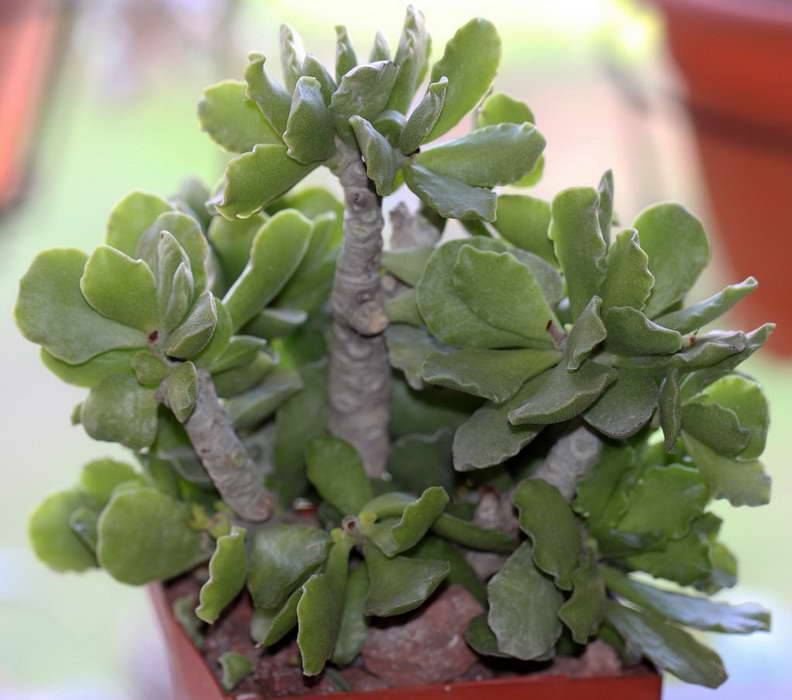

Description: Adromischus cristatus var. zeyheri is a dwarf succulent that forms groups of stems. The Zeicher variety is a light green form of Adromischus cristatus, which is distinguished by the absence of aerial roots and glandular hairs on the leaves, inflorescences and flowers.
Stems: up to 8 cm long, tuberous, not very branched and without aerial roots. Roots: fibrous. Leaves: larger than typical species, light green, not variegated, waxy, flattened, oblong, about 4-7 cm long and 2.2-5.5 cm wide, broadly triangular, wavy / curled at the edges. Flowers: Very small, sessile, cream-white, on an inflorescence 25-60 cm high. Flowering season: mid-summer. Fruit: Dry capsule.
Adromischus marianae f. alveolatus
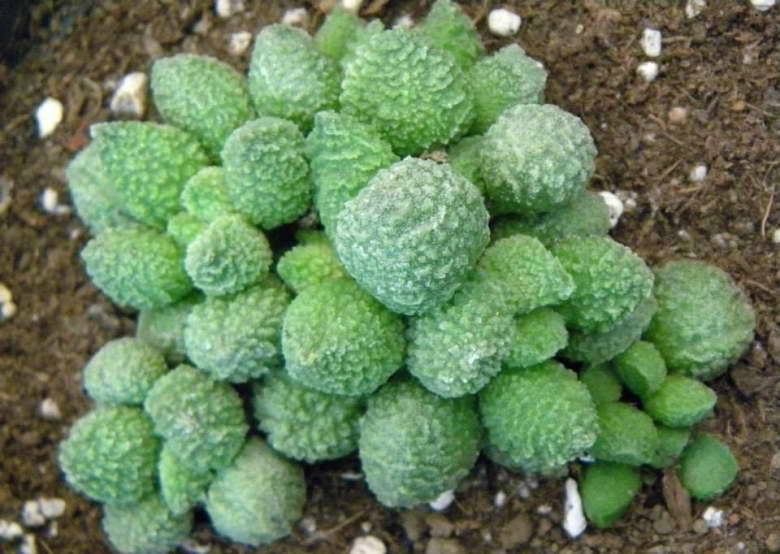

Description: Adromischus marianae f. alveolatus is one of countless morphological and geographic variants of the highly variable Adromischus marianae. It is a natural form similar to Adromischus marianae f. herrei, but differs in peculiar leaves that are shorter, less sharp, as a rule, stronger and with a very rough surface. Bumps sometimes form, and very often they come together to form small and irregularly reticulated, low, rounded ridges. Some of these plants are quite unusual in shape.
Form: It is a branched small perennial succulent with thick stems. Roots: tuberous, sometimes thick fibrous. Stem: 1-2 cm long, up to 5 mm in diameter, thick ascending, often narrowed at the base, pale yellow-green or yellow-green, sometimes whitish, wrinkled.
Leaves: up to 3.5 cm long and 20 mm wide, short petiolate, sub-opposite, horizontal to erect, usually symmetrical, subspherical to ovoid or elliptical, longer than wide, often spiny higher, with tips at both ends , verrucous, often alveolar, sometimes with small tubercles, spotless, from gray-green to grayish-brown with a thick coating. The base is wedge-shaped. The edge is only slightly raised and not horny; the apex is often subacute.
Inflorescence: Simple spiny panicle with 1-flower raceme 10-25 cm high, peduncle up to 17 cm long, up to 2.5 mm thick, grayish-yellow, sometimes zigzag, below 4 cm and about 5. Deltoid, dusty sterile bracts wide 1 mm or more and 2 mm long; Peduncle from 10 to 15 cm.
Flowers: buds are slightly corrugated. Flowers up to 15 straight, single, usually arranged in a spiral at a distance of about 1 cm from each other, sometimes more closely or almost opposite. Pedicels are white, 4 to 7 mm long, 2 to 3 mm long, 1 to 1.2 cm long, pale pink, with 5 petals fused at the base, forming a grayish-white cylindrical tube, gradually tapering towards the tip, at first straight line, later diverging. Corolla parts 2-3 mm long and 2 mm wide, deltoid, sharp, spreading or curved, white with purple edges, coarse and with frequent hairs, mainly in the throat. The anthers do not protrude from the rim tube. The perianth tube is glaucous, yellowish at the base, green above, maroon at the apex, bright green inside, 15 mm long, 5 mm in diameter, slightly overestimated, narrowed just below the middle.Fibers in two rows near the middle of the tube, about 5 mm long, green. Seeds: very small.
Cooper's adromiscus, crested (cristatus), three-pistil
Adromischus cooperi - a low fleshy plant with straight branching stems about 8-10 cm high. The leaf plates are oval, elongated, pointed at the end, thick, smooth, light green, with numerous burgundy specks and wavy edges. The length of the leaves is from 5 to 7 cm. The flowers are tubular, reddish-green, with a pink or snow-white edging, 1 - 2 cm long, collected in a spike-shaped inflorescence.
Adromischus cristatus (Adromischus cristatus) - This is a low succulent, reaching 12 - 15 cm, the shoots of which are straight at first, but gradually become creeping. Stems along the entire length are covered with filiform, short aerial brown roots. The leaf plates are triangular, convex, juicy, pubescent, wavy along the edge, rich green. The leaves are collected in rosettes. Their length is 5 cm, thickness is about 1 cm. They are attached to short petioles. The flowers are greenish-white with a pink border.
Three-pistil adromiscus (Adromischus trigynus) - a variety with an unusual appearance. It is a weakly branching bush 10-15 cm long. The leaves are rounded or elongated, up to 5 cm long, up to 3 cm wide. The color of the leaf plates is dark green with brown spots on the surface and in the lower part. Flowers are five-petal, tubular, reddish-brown.
Growing problems
It is practically not affected by pests, it is usually too tough for a tick. Sometimes it can be affected by mealybugs.
This pest can be found in the axils of the leaves - like white cotton-like lumps. Pests can be selected by hand, wipe the leaves with a cotton swab dipped in alcohol or soapy water.
Of insecticides, it is advisable to use aktara or confidor. Aktara is diluted at the rate of 1 g of the drug per 10 l of water, confidor - 1 ml per 5-10 l of water. Re-treatment after 2 weeks.
Growing difficulties
If the rules of agricultural technology are not followed, the following problems may appear:
- Root rot - manifests itself when water enters a deciduous outlet. An urgent transplant with preliminary pruning of the affected parts of the plant and drying will help to solve the problem.
- Yellowing and wilting of foliage - appears with waterlogged soil and sunburn. The situation with high humidity is corrected by transplanting. In case of a burn, the plant can, after a while, restore the color of the leaves on its own, or it begins to shed them. The burn does not require specific treatment, just remove the adromiscus to another place and ensure sufficient watering.
- Cracking of sheet plates - appears when there is insufficient watering. They correct the situation by regulating agrotechnical conditions, teaching watering and conducting periodic spraying.
- Deformation of leaves and shoots - signals a lack of lighting. Moving the flower pot to a brighter room or organizing additional lighting will help solve the problem.
Failure to comply with the rules of agricultural technology can lead to the reproduction of insect pests. Most often, in such cases, the following appear on succulents:
- aphid - small green or black bugs settle on the leaves and feed on their juice, which leads to drying out;
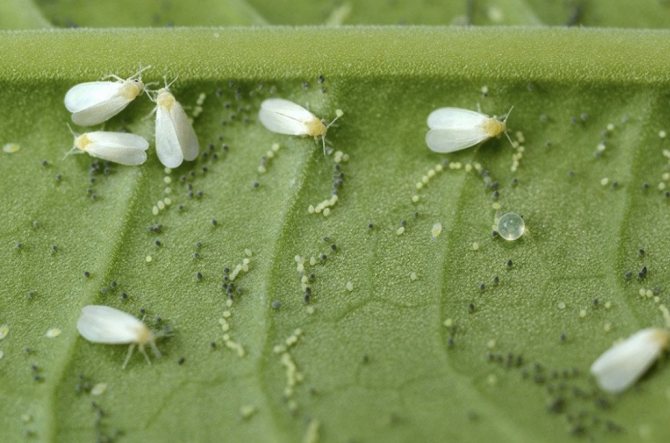

- mealybug - in the axils of deciduous rosettes, a sugary cobweb-like substance appears, which interferes with normal photosynthesis;
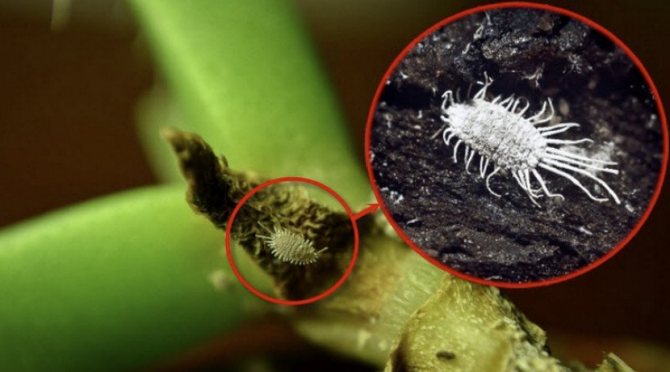

- spider mite - the leaves are covered with white bloom, they lose their density and turn yellow.
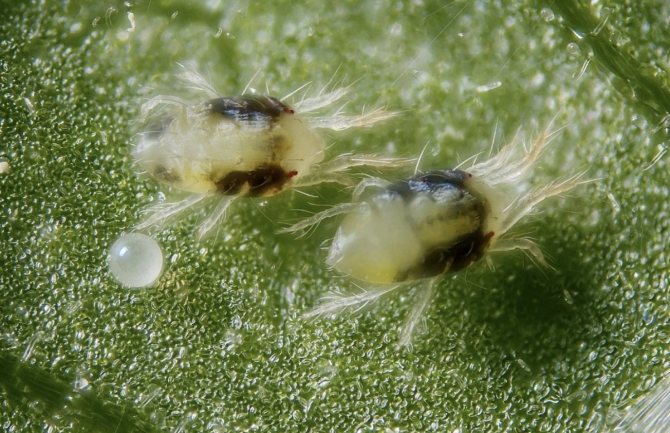

Pests are removed manually using a cotton swab dipped in a solution of potassium permanganate. Then the soil and the plant are treated with a solution of Fitoverm:
- against aphids - 1 ampoule / 0.6 l of water;
- from spider mites and worms - 1 ampoule / 2.5 l of water.
Processing is carried out every 7 days, 4 times.
Did you know? After watering, succulents store liquid in the aquiferous parenchyma. This is a tissue that consists of large vacuoles filled with sap. In adromiscus, this tissue is found in leafy plates. In the wild, a plant absorbs so much moisture that its weight increases immediately by 2-3 times.
Adromiscus is an unpretentious house plant that belongs to cactus. It tolerates heat and dry air well. Resistant to diseases subject to elementary agrotechnical rules.
What's interesting about andromiscus?
Adromiscus is a herbaceous perennial of the semi-shrub type up to 15 cm high. The plant has a creeping root and a thick, lodging stem, covered with terracotta air roots. Through them, the succulent absorbs moisture and nutrients from the air. The root system of adromiscus consists of many fine hairs, therefore, they require careful handling during transplantation. Outwardly peculiar foliage grows from a short stem - round or triangular in shape, fleshy, monochrome green or with dark blotches. The average width of a leaf plate is 5–6 cm with a thickness of 1 cm.
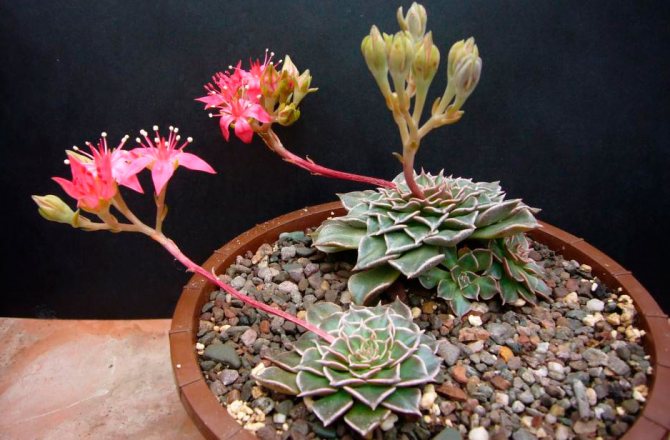

Adromiscus, when blooming, throws out a long arrow, at the top of which white-pink inflorescences bloom
Adromiscus blooms in summer with spectacular tubular inflorescences of a white-pink tone, grouped in spike-shaped brushes. They are attached to long and strong peduncles.
Breeding methods
There are 2 methods of reproduction of adromiscus:
- dividing the bush;
- sheet.
The division of the bush is carried out only in the phase of active vegetation of the plant - in early spring. Examine the plant carefully, pick up the thickest cuttings with fully developed leaves and air roots.
Important! The cutting procedure is performed with a clean knife, disinfected in 1% potassium permanganate solution.
Separate the selected stalk with a knife and dry the roots. To shorten the time, instead of drying, you can treat the roots with wood ash. In the previously prepared universal soil for cacti, make grooves and place the cuttings in them. Around the shoots, the soil should be tamped well and the pot should be covered with a plastic bag.
As soon as you notice new buds on the shoots, you can remove the bag. Do this gradually so that the plants get used to the change in humidity. On the first day, leave the plant without the bag for 1 hour. Over the course of the week, increase the interval of stay without the package by 1-1.5 hours. On day 8, remove the polyethylene completely.
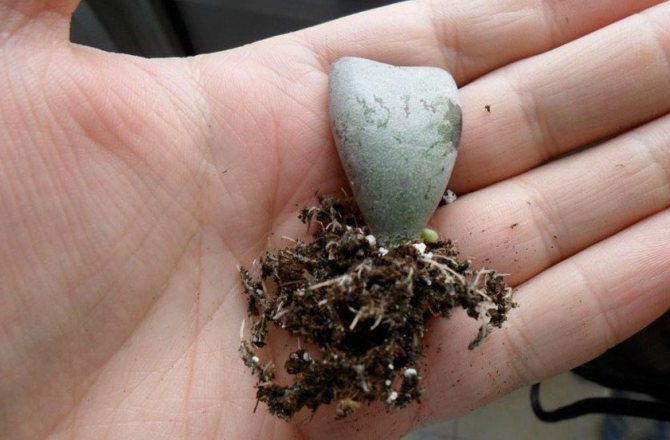

Reproduction by leaves can be carried out at any convenient time. Pick up a large leaf blade and carefully remove it with a clean knife. Place it in a pot on top of the soil and cover with foil. Set the pot aside in a warm, dark place. After 7-10 days, roots will appear on the leaf plate. During this period, the area with roots must be covered with earth, about 0.7-1 cm.
After a while, "kids" will begin to appear on the sheet. They can be left as they are, or they can be separated and placed in different pots. The separation of "children" should be carried out so that each has at least 1 root. Watering throughout the entire period of active growing season is carried out as the soil coma dries up. In a year, the "kids" will become fully formed plants.
Species
The species of Adromischus
are divided into five, based on their shared characteristics and relationships:
Section 1 (Adromischus)


Flowers of a Section 1.species (Adromischus filicaulis
)
Flowers bright green, tubular, with short, wide, triangular, recurved lobes. Anthers protrude from flower tube. Indigenous mainly to the western, winter-rainfall regions of South Africa.
- Adromischus alstonii
- Adromischus hemisphaericus
- Adromischus roaneanus
- Adromischus liebenbergii
- Adromischus bicolor
- Adromischus filicaulis
Adromischus filicaulis subsp. marlothii - Adromischus montium-klinghardtii
- Adromischus subdistichus
Section 2 (Boreali)
Grooved, tubular flowers, with ovate-triangular, recurved lobes that are undulated on the margins. Anthers protrude from flower tube. Indigenous to the arid, summer-rainfall interior of Southern Africa.
- Adromischus schuldtianus
- Adromischus trigynus
- Adromischus umbraticola
Section 3 (Brevipedunculati)
Grooved, funnel-shaped flowers with acuminate-triangular, widely spreading lobes, born on long stalks. Inflorescence branched. Usually spreading or stoloniferous plants.
- Adromischus caryophyllaceus
- Adromischus fallax
- Adromischus humilis
- Adromischus phillipsiae
- Adromischus nanus
- Adromischus diabolicus
Section 4 (Incisilobati)
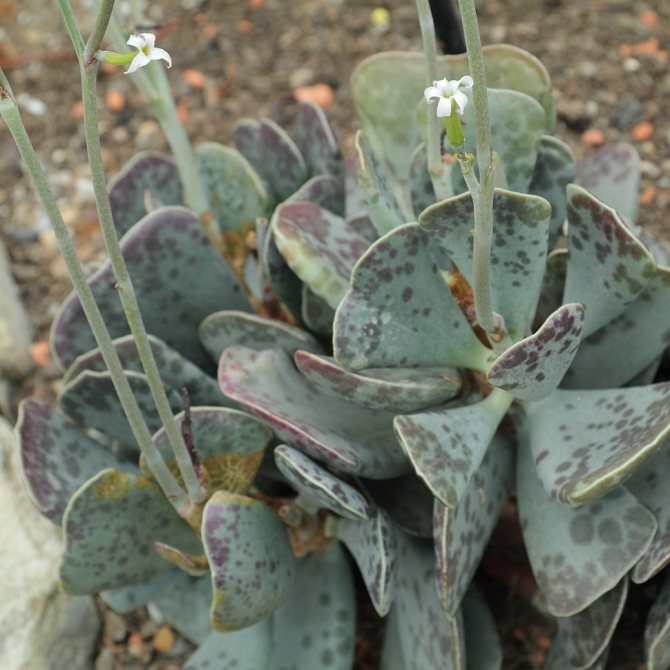

Flowers of a Section 4. species (Adromischus triflorus
)
Tubular flowers with elongated lanceolate-triangular lobes. Plants with short, compact, upright stems.
- Adromischus maximus
- Adromischus sphenophyllus
- Adromischus maculatus
- Adromischus inamoenus
- Adromischus triflorus
- Adromischus mammilaris
- Adromischus halesowensis
Section 5 (Longipedunculati)
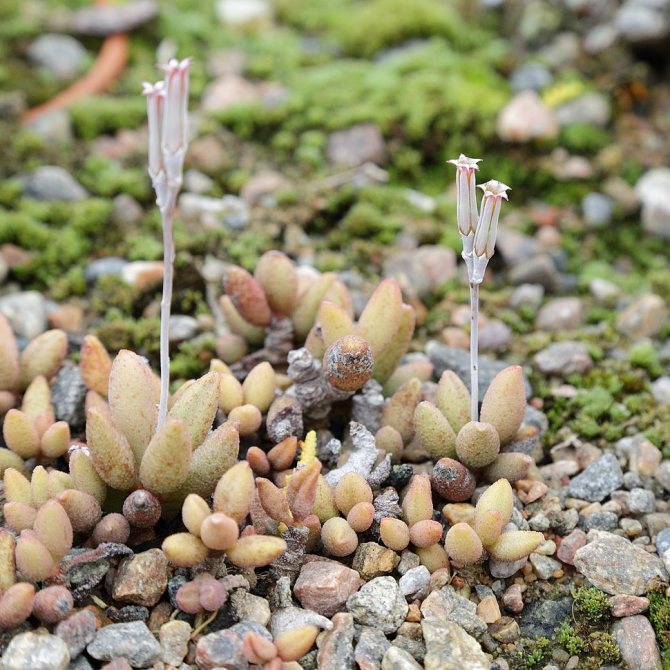

Flowers of a Section 5. species ()
Pale or pubescent inflorescence with elongated lanceolate-triangular lobes
- Adromischus cristatus clavifolius
- Adromischus cristatus mzimvubuensis
- Adromischus cristatus schonlandii
- Adromischus cristatus zeyheri
- Adromischus marianae immaculatus
So-called Adromischus oviforme
specimens are actually
Adromischus filicaulis
subsp.
marlothii
;
Adromischus oviforme
doesn’t actually exist.
Breeding process
Sprout ready for planting in the ground
Adromiscus can be propagated independently using leaf cuttings. It is best to do this in the spring. To reproduce a succulent with leaves, you need to perform the following steps:
- Carefully cut the leaves off the mother plant.
- Leave the material for 2 hours in a dark place to dry.
- Plant the leaves in small containers filled with a special substrate. It is best to use a composition based on peat, river sand and vermiculite. A special soil mixture that is designed for succulents is also perfect.
- The stalk will take root in about 1 month.
Sufficiently wide pots are suitable for adromiscus. Their diameter should be greater than their height. Such a capacity will provide the plant with maximum comfort.
Possible problems and solutions
Adromiscus has good disease and pest resistance. Some inconveniences can be caused by spider mites, aphids or mealybugs. If damage or the thinnest cobweb is found, treatment with insecticides (confidor, aktara) should be carried out immediately. Sometimes it is enough to wipe the affected areas with a cotton swab dipped in soap or alcohol solution.
Cracked leaves testify to the excess watering of the plant. Too flooded, it can start to rot. If you managed to notice the problem right away, there is a chance to save the entire bush by removing only single shoots. In a more severe case, you will have to cut off a few healthy leaves for propagation, and discard the rest with the soil.


If the stem begins to stretch strongly, and the lower leaves fall off, then the adromiscus does not have enough light. You need to move the pot to the south window. If this is not possible, you should use a special lamp.
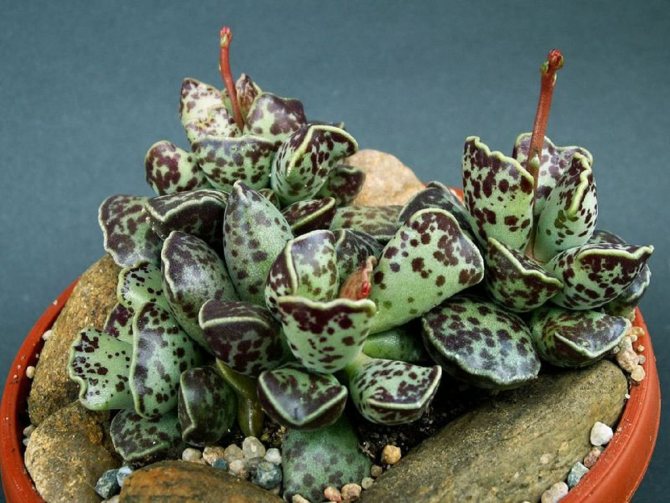

Similar varieties of succulents
Adromiscus spotted outwardly similar to plants of its kind and family.
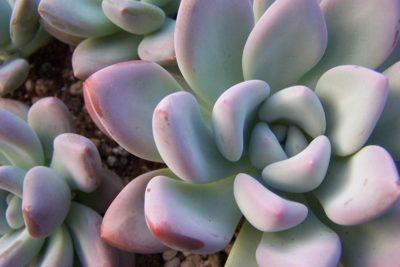

Pachyphytum. A plant with a creeping or lodging stem. The leaves are convex, watery, dense, collected in whorls. Sepals and leaves are covered with a waxy coating.- Cotyledon. A plant with thick and short stems. The leaves are juicy, dense, fleshy, oppositely located. Flowers drooping in the shape of a bell, white.
- The fat woman is tree-like. A plant with a squat, thick trunk. The leaves are elongated, watery, dense, greenish-gray in color, on their surface there is a layer of whitish bloom.
- Graptopetalum. A plant without a stem. It has dense, watery, cordate leaves, dark green in color, matte, with a sharp end. It blooms with pink flowers in the shape of a lily.
- Oscularia. Shrub succulent. The leaves are juicy, gray-gray-green, symmetrically opposite, triangular, accrete at the base, expanding upward. All these flowers are similar to adromiscus in the structure of dense, watery leaves.
Table: optimal growth conditions for adromiscus, depending on the season
| A period of time | Lighting | Humidity | Temperature | Location |
| Spring Summer | The plant prefers bright light, but with protection from the midday heat (otherwise burns on the leaves are likely) | During flowering, adromiscus needs high humidity. Dry air is preferred the rest of the time. | + 25-30 ºС (in hot weather they regularly ventilate the room or place a flower near an open window) | Place a flower pot on the south, west or east windowsill |
| Autumn winter | + 7-15 ºС |
The soil for growing adromiscus should be with a lot of sand. It is allowed to use a ready-made substrate for succulents or cacti. You can prepare it yourself by mixing the following components:
- land from the garden - two parts;
- humus - two parts;
- coarse sand - three parts.
It will be useful to mix a handful of bone meal, ground eggshells and charcoal into the resulting soil mixture. Brick chips are used as drainage. A pot for planting a plant is selected with an average volume, approximately 15 cm in diameter.
1. Seven Secrets of Success:
Description. A small, slow growing succulent plant native to South Africa. Stems are semi-recumbent, short, 3 - 7 cm long with dense reddish-brown aerial roots. Sometimes you can also find stemless species, where the leaves form a rosette. Leaves are thick, cylindrical or hemispherical, upright, triangular, pale green, grayish or reddish 3-6 cm long and 1-3 cm wide, covered with tiny hairs. Some species have foliage that is wavy along the ridge. During the flowering period, the plant throws out an impressive height of a peduncle, on which there are discreet, green, long, tubular flowers with reddish-white or white petals. Compact dimensions allow you to assemble a large collection that takes up little space on the windowsill.
Reproduction
Adromiscus reproduces easily vegetatively:
- Take a mature leaf from the middle or top of the trunk.
- Air dry for 2-3 hours.
- Place the base on moistened soil in a pot and secure.
- Spray the soil periodically with a spray bottle and wait for rooting.
After 1–2 months, young leaves appear, and the stalk dries out over time and falls off the young adromiscus.
Watch the video on how to propagate succulents with leafy cuttings.
Post-flowering care
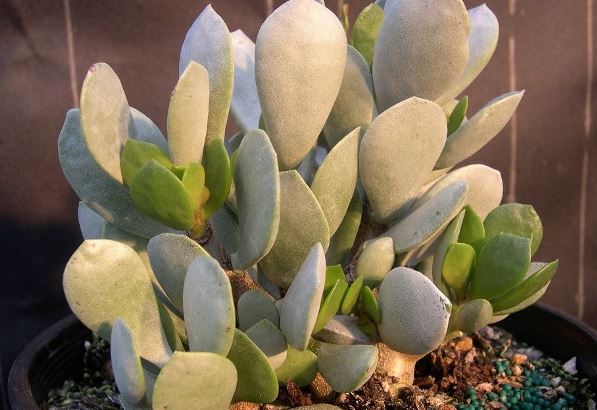

A peduncle with fading buds looks unsightly, but you should not rush to get rid of it. If you cut off the leg immediately, there is a risk of decay of the remaining part. In addition, after flowering, the plant is greatly weakened and cannot resist even weak bacteria.
You need to wait 2-3 weeks after flowering so that the moisture from the peduncle is gone and it dries... Then cut off the leg with a clean pruner or knife and sprinkle the cut with ash or charcoal.
Difficulties of content
When growing a succulent, you can face a number of difficulties:
- the plant is susceptible to attacks by pests - scale insects, aphids, mealybugs, spider mites;
- with waterlogged soil, root decay is possible, the plant can become watery, soft, and a disease begins - gray rot;
- due to insufficient lighting, the stem of the plant is stretched, the leaves become loose and dull;
- if water gets into the outlet of the leaves, then the plant rots;
- when the plant ages, the lower tier of its leaves becomes yellow and they fall off;
- when the ground part of the succulent receives a sunburn, the leaves begin to turn yellow and dry out;
- when the soil dries up, the leaves of adromiscus begin to crack.
Adromiscus spotted is very easy to grow at home. Subject to a few simple rules, this African inhabitant will be able to delight the grower with his unsurpassed appearance for a long time.
If you find an error, please select a piece of text and press Ctrl + Enter.
Care rules
Having bought adromiscus, it is not difficult to master it at home. This flower even loves to be forgotten about it sometimes, and not surrounded by constant care. The dweller of the African wasteland prefers bright sun and limited moisture. In summer, the optimum temperature is +30 ° C. However, care should be taken when placing plants on the windowsill. Sunshine without fresh air can burn leaves. In winter, cold snaps up to + 10 ... + 15 ° C are allowed, if the temperature drops to +7 ° C, the plant may die.
It is undesirable to spray the leaves, they perfectly tolerate the dry air of heated rooms, but water droplets will lead to decay or sunburn. All damaged leaves should be removed immediately so that the disease does not spread further.
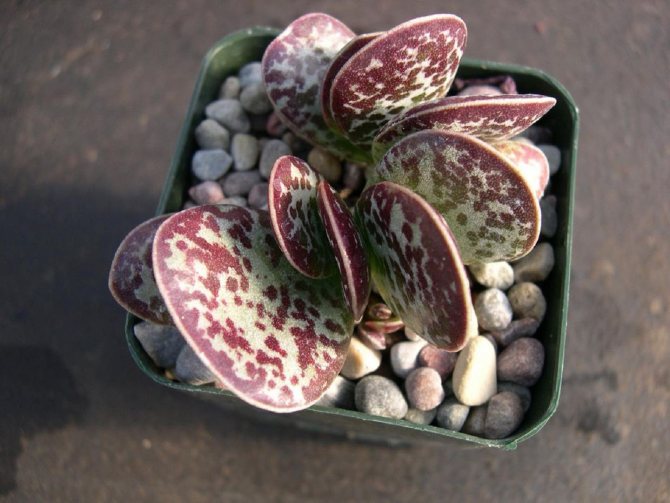

Watering adromiscus is necessary rarely enough so that the soil has time to dry completely. It is better to pour liquid into a tray or away from a leaf outlet.The accumulation of water droplets leads to leaf disease. In the cold period, watering is done once a month or even less often. From mid-April, you can monthly feed the bushes with mineral fertilizers for cacti.
Choosing a place for planting and preparing the soil
The plant is considered to be very light-loving. It needs full lighting even in the winter season. This bush easily tolerates direct sunlight.
In the warm season, the optimal temperature regime is 25-30 degrees. With the arrival of cold weather, it must be reduced to 10-15 degrees. The plant needs systematic ventilation. This is especially true in the heat.
Adromiscus is not sensitive to moisture parameters. It grows well in rooms with dry air. In this case, it is not required to spray the plant.
It is recommended to plant the crop in soil that is intended for succulents. At the same time, a small amount of sand must be added to its composition.
For self-preparation of the substrate, it is recommended to mix 3 parts of sand, 2 parts of earth, 2 parts of leaf humus and 1 part of charcoal. It is also recommended to add a little crushed eggshell to the composition. Lime will be an excellent ingredient.
It is recommended to transplant adromiscus in the spring. This is not allowed to be done every year, but only if necessary.
All the greatness of adromiscus in the photo:
Adromishus marianae var. Herre, or Marianne Hera Adromischus marianae v. herrei
Eonium tree breeding and grooming secrets
Syn .: Cotyledon herrei, Adromischus herrei. Leaves are elongated, rough, green or red-brown, variegated, juicy, 2-3 cm long.
Adromishus - conditions of detention


A. schuldtianus with codex
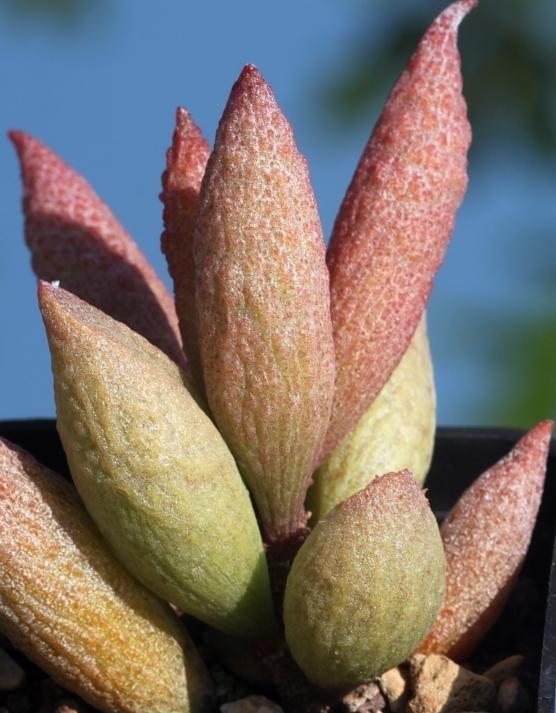

A. marianae var. immaculatus
The soil. Substrate - crumbly, with b. quantity of sand. It is useful to add brick chips and pieces of coal to the soil. Equal parts of lumpy clay-sod land, leaf humus and river sand. Temperature. In summer - 18-28 ° С, in winter - 10-15 ° С. If the room is very hot, then you should provide access to fresh air. In winter, adromiscus is kept in a cool, bright place. Lighting. Requires a lot. light, it must be placed on a well-lit window sill, and in the summer it can be taken out onto the balcony. Tolerates direct sunlight. Suitable for growing near windows to the south. directions, however, in the summertime should be shaded from the midday sun. The windows are north. the direction of adromiscus may lack lighting, especially in winter. Watering. Regular in summer, but not plentiful, some time after the top layer of the substrate dries up. In autumn and winter, it is rare, after the substrate is dry, or without watering, depending on the T content. Watering is carried out with soft, settled water, room T.


A. marianiae Bryan Makin
Top dressing. Spring-summer - once a month with fertilizers for cacti. Air humidity. It is useful to spray in the summer. But Adromiscus tolerates dry indoor air well. There is no need for high values of air humidity. Rest period. Autumn winter. They are kept at 10-15 ° C with good lighting, rarely watered, or the content is dry. Transfer. As needed, in spring when the pot is filled with roots. The capacity is small. Provide good drainage at the bottom of the pot. After transplanting, watering is very careful - little by little, so as not to cause rotting of the roots. Reproduction. Cuttings, the leaves are torn off and dried for several days, planted in a moist soil mixture, covered with a bag and placed in a warm place. You can root in wet sand, vermiculite, or a mixture of succulent substrate and sand. Roots usually grow within 1 month. Rooted cuttings and leaves are planted in 5-7 cm pots. The composition of the soil is the same as for seedlings. Caring for them is the same. Species with red and dark green spots on the leaves are popular, but with a lack of light, these spots disappear. Like all bastards, adromiscus are unpretentious and undemanding to care for, in addition, they are rarely affected by pests.The main types: adromiscus comb, adromiscus copper, adromiscus Pelnitz, adromiscus three-pistil, adromiscus refined.
- Fat women, aka Crassula
- Sedum, aka Sedums
- Kalanchoe
- Cotyledon
- Aeoniums
- Fats (other different kinds)
- Pachyphytum
- Echeveria
- Classification of succulents

